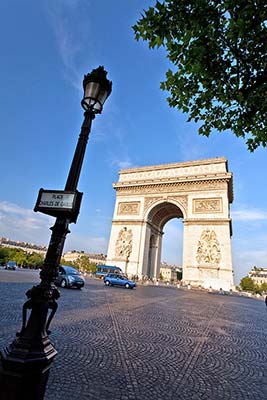
▲▲▲Notre-Dame Cathedral (Cathédrale Notre-Dame de Paris)
▲Deportation Memorial (Mémorial de la Déportation)
Map: Major Museums Neighborhood
▲▲▲Orsay Museum (Musée d’Orsay)
▲▲Orangerie Museum (Musée de l’Orangerie)
Louvre Wine Museum (Les Caves du Louvre)
▲▲▲Eiffel Tower (La Tour Eiffel)
National Maritime Museum (Musée National de la Marine)
Architecture and Monuments Museum (Cité de l’Architecture et du Patrimoine)
▲Quai Branly Museum (Musée du Quai Branly)
▲Paris Sewer Museum (Les Egouts de Paris)
▲▲Rue Cler
▲▲Army Museum and Napoleon’s Tomb (Musée de l’Armée)
▲▲Marmottan Museum (Musée Marmottan Monet)
▲Latin Quarter (Quartier Latin)
▲▲Cluny Museum (Musée National du Moyen Age)
Delacroix Museum (Musée National Eugène Delacroix)
▲Luxembourg Garden (Jardin du Luxembourg)
Arab World Institute (Institut du Monde Arabe)
▲Petit Palais (and Musée des Beaux-Arts)
▲Paris Ferris Wheel (Roue de Paris)
La Défense and La Grande Arche
▲▲Opéra Garnier (Opéra National de Paris—Palais Garnier)
Map: Opéra Garnier—Second Floor
▲▲Jacquemart-André Museum (Musée Jacquemart-André)
MARAIS NEIGHBORHOOD AND NEARBY
▲▲Carnavalet Museum (Musée Carnavalet)
▲▲Picasso Museum (Musée Picasso)
▲Jewish Art and History Museum (Musée d’Art et Histoire du Judaïsme)
Map: Marais Neighborhood & Nearby
Holocaust Memorial (Mémorial de la Shoah)
▲▲Pompidou Center (Centre Pompidou)
La Coulée Verte Promenade-Park
▲▲Père Lachaise Cemetery (Cimetière du Père Lachaise)
Victor Hugo’s House (Maison Victor Hugo)
▲Montmartre Museum (Musée de Montmartre)
Paris is blessed with world-class museums and monuments—more than anyone could see in a single visit. To help you prioritize your limited time and money, I’ve chosen what I think are the best of Paris’ many sights. I’ve clustered them into walkable neighborhoods for more efficient sightseeing.
In this chapter, some of Paris’ most important sights have the shortest listings and are marked with a  . That’s because they are described in much more detail in one of my self-guided walks or tours. A
. That’s because they are described in much more detail in one of my self-guided walks or tours. A  means the walk or tour is available as a free audio tour (via my Rick Steves Audio Europe app—see here). Some walks and tours are available in both formats—take your pick.
means the walk or tour is available as a free audio tour (via my Rick Steves Audio Europe app—see here). Some walks and tours are available in both formats—take your pick.
To connect some of the most central sights, follow my Historic Paris Walk (see the next chapter), which takes you from Notre-Dame to Sainte-Chapelle, and ends on Pont Neuf, very near the Louvre and Orsay.
For general tips on sightseeing, see here in the Practicalities chapter. For advice on saving money, see “Affording Paris’ Sightseeing” in this chapter.
Most sights of any importance in Paris sell tickets online for no additional cost—though some charge a small booking fee. At the Louvre, Sainte-Chapelle, and Versailles, you won’t get in without a timed-entry ticket bought in advance. And, although advance tickets are not technically required for the Eiffel Tower, Orangerie, Catacombs, and the Orsay, I recommend booking ahead to assure you get your preferred date and time. At some sights, you can drop in and take your chances (but I wouldn’t—unless it’s off-season).
Even where advance tickets are not required, buying ahead lets you avoid the slow ticket-buying lines (though you’ll still likely have to wait in a security line). Combine this strategy with a Paris Museum Pass (described below), and you’ll save both time and money at most sights.
You can also buy advance tickets for activities and cultural events such as the Bateaux-Mouches river cruises, Sainte-Chapelle concerts, and performances at the Opéra Garnier.
Buy your ticket online, keep the digital ticket easily accessible on your phone, and bypass any ticket-buying lines when you get to the sight.
Try to book directly on the sight’s official website. The process can be cumbersome, as you may need to create an account and go through several steps. If you’re already in Paris, ask your hotelier for help. If the sight shows no availability, it’s worth trying a third-party seller like FNAC (see “Last-Ditch Ticket Tips,” later).
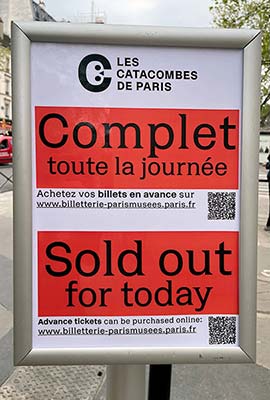
You’ll select your preferred date and entry time (usually with a 30-minute window to enter), then make the purchase with your credit card. If you have a Paris Museum Pass and are reserving a sight covered by the pass, look for the pass-holder option (sometimes called free ticket option), which lets you book an entry time for free. You may need to input your Museum Pass number. Some sights (like the Louvre) have limited allocations for pass holders, so their websites may still show entry times available for ticket purchases but none for pass holders.
Once you’ve booked, you’ll receive an email—usually with a QR code—that acts as your digital ticket. (If you don’t get the email, check your junk folder.) When you arrive at the sight, look for a line marked “ticket holders” (avec billet). There may still be a wait to enter, but when you get to the front, pull up the digital ticket on your phone to get in.
The Paris Museum Pass admits you to many of Paris’ most important sights over two, four, or six consecutive days—saving you money if you visit several included sights (2 days-€55, 4 days-€70, 6 days-€85; no youth or senior discounts, but many museums offer free admission to those under age 18—see “Families,” later). The pass pays for itself with four key admissions in two days (for example, the Arc de Triomphe, Orsay, Sainte-Chapelle, and Versailles). We’ve left the Louvre off this list because of their limited pass-holder ticket allocations, which can make reserving an entry time difficult.
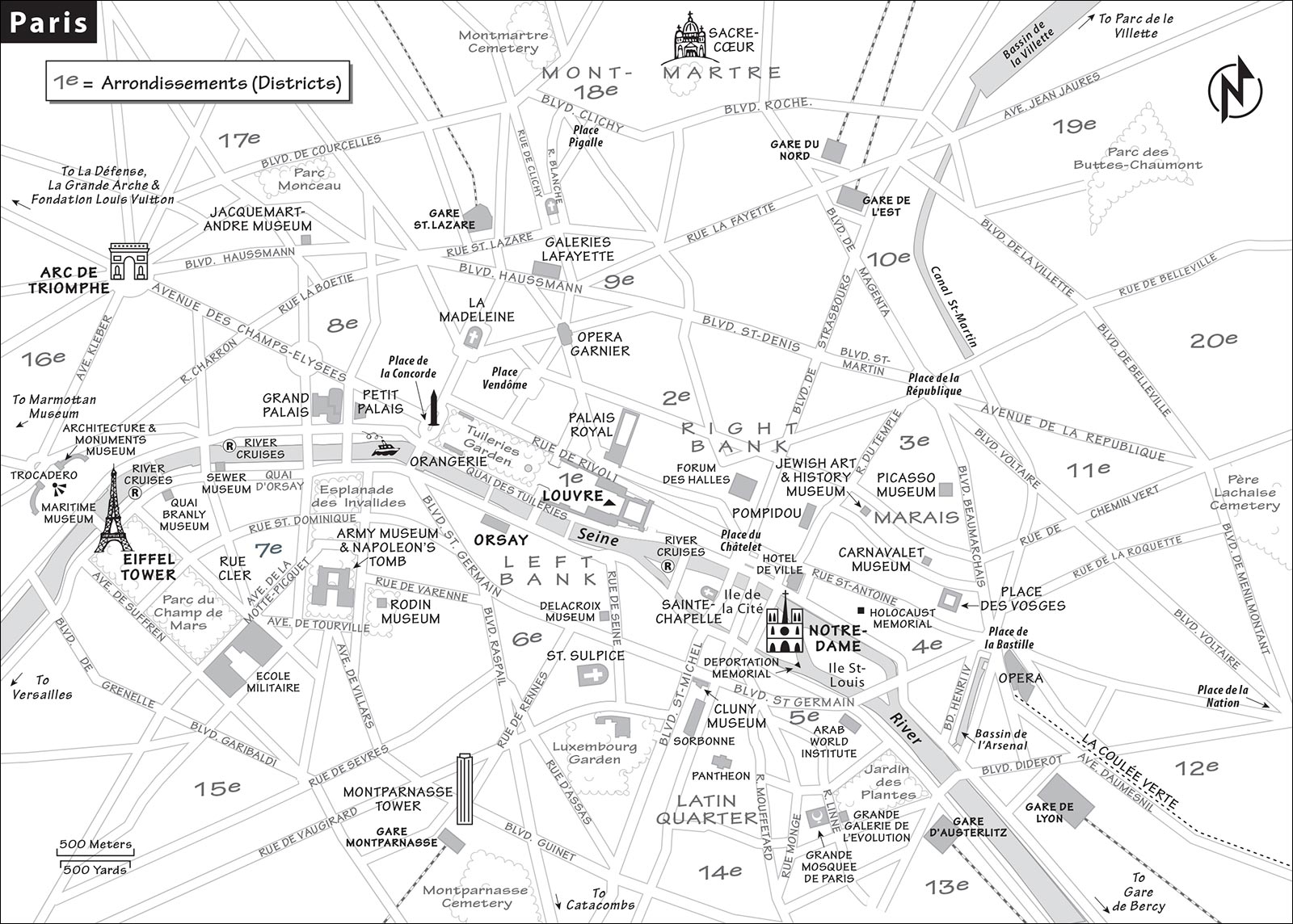
Pertinent details about the pass are outlined here. For more info, and to purchase the pass, visit www.parismuseumpass.com.
If you buy the pass online, you can download and print a hard copy to show as you enter museums, or keep it on your phone (take a screenshot and save it in your Favorites photo album for quick access). The pass may be digital-only by the time you read this; paper passes are being sold—until the stock runs out—at participating museums, monuments, and TIs (including those at Paris airports, small fee added). Avoid buying the pass at a major museum where the supply can be spotty and lines long.
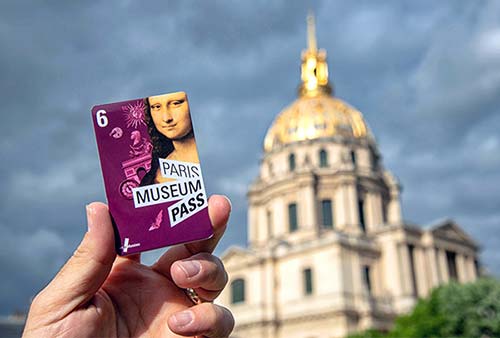
Families: The pass isn’t worth buying for children and teens, as most museums are free or discounted for those under age 18 (teenagers may need to show ID as proof of age). If parents have a Museum Pass, kids can usually skip the ticket lines as well. A few places may require everyone—even pass holders—to stand in line to collect your child’s free ticket.
To determine whether the pass is a good value for your trip, tally up ticket prices for what you want to see and compare against the cost of the pass. Here’s a list of key sights and their admission prices without the pass:
| Louvre (€17) | Cluny Museum (€12) |
| Orsay Museum (€16) | Pompidou Center (€15) |
| Orangerie Museum (€12.50) | Picasso Museum (€14) |
| Sainte-Chapelle (€11.50) | Conciergerie (€11.50) |
| Arc de Triomphe (€13) | Château de Fontainebleau (€14) |
| Rodin Museum (€13) | Château de Chantilly (€17) |
| Army Museum (€15) | Versailles (€19.50 ticket includes the Château, Trianon, and Domaine) |
| Panthéon (€11.50) |
Notable sights not covered by the pass include the Eiffel Tower, Montparnasse Tower, Marmottan Museum, Opéra Garnier, Jacquemart-André Museum, Sewer Museum, Catacombs, Sacré-Cœur’s dome, and the ladies of Pigalle. The pass also does not cover these recommended sights outside Paris: the Gardens at Versailles on Spectacle days, Vaux-le-Vicomte, Château d’Auvers in Auvers-sur-Oise, and Monet’s Garden and House in Giverny.
At covered sights where reservations are required—such as Versailles—even with the pass you must book a free timed entry online in advance (see “Booking Tickets in Advance,” earlier; select a date and time within your pass validity period). At sights where reservations aren’t required, the pass often allows you to skip ticket-buying lines—which can save some waiting, especially in summer. Another benefit is that you might pop into lesser sights that otherwise may not be worth the expense.
Plan carefully to make the most of your pass. Start using it only when you’re ready to tackle the covered sights on consecutive days. The pass allows one entry per sight, so make sure you’re ready to commit to a full visit before entering. The pass is activated at the time of first use and is time-based (not days-based). For example, a two-day pass gives you 48 hours of use from the time you activate it (so if your first entry is at 13:00, you get 48 hours from 13:00). Make sure the sights you want to visit will be open when you want to go (many museums are closed Mon or Tue).
The pass provides the best value on days when sights close later, letting you extend your sightseeing day. Take advantage of late hours on selected evenings or times of year at sights like the Arc de Triomphe, Pompidou, Orsay, and Cluny (see the “Paris for Early Birds and Night Owls” sidebar in this chapter). After your pass expires, visit free sights (many are free every day; see the “Affording Paris Sightseeing” sidebar in this chapter) and those not covered by the pass.
You can’t skip security lines, though at a few sights (such as the Orsay Museum and Arc de Triomphe) pass holders enjoy “priority lines.” Once you pass security, look for signs designating the entrance for reserved ticket holders. If it’s not obvious, don’t be shy—boldly walk to the front of the ticket line, hold up your pass, and ask the ticket taker: “Entrez, pass?” (ahn-tray pahs). For some sights, such as the Orsay Museum, I’ve identified pass-holder entrances on the maps in this book.
If you can’t get an online reservation for the date you want, you can buy skip-the-line “coupe-file” tickets (pronounced “koop feel”) through third party vendors—sometimes for a high fee. You’ll find coupe-file tickets at TIs, FNAC department stores (common, ask your hotelier about the nearest one, www.fnactickets.com), and travel-service companies such as Fat Tire Tours (see here). Compare your options: Some allow you to skip the ticket-buying line, while others provide a “guide” to escort you into the sight (small fee at TIs, 10-20 percent surcharge elsewhere).
 Connect the following sights with my Historic Paris Walk chapter and
Connect the following sights with my Historic Paris Walk chapter and  free audio tour, which also provide more detailed visiting information and descriptions for Notre-Dame, the Deportation Memorial, Ile St. Louis, Sainte-Chapelle, and the Conciergerie.
free audio tour, which also provide more detailed visiting information and descriptions for Notre-Dame, the Deportation Memorial, Ile St. Louis, Sainte-Chapelle, and the Conciergerie.
This 860-year-old cathedral, packed with history, is recovering from a devastating fire in 2019 (though thankfully, much of what made the church’s interior famous was salvaged). While the interior and some of the surrounding areas are closed for several years (possibly reopening later in 2024), you can still appreciate its monumental exterior. With a pair of 200-foot-tall bell towers, a facade studded with ornate statuary, beautiful stained-glass rose windows, famous gargoyles, a picture-perfect Seine-side location, and textbook flying buttresses, there’s a good reason that this cathedral of “Our Lady” (Notre-Dame) is France’s most famous church.
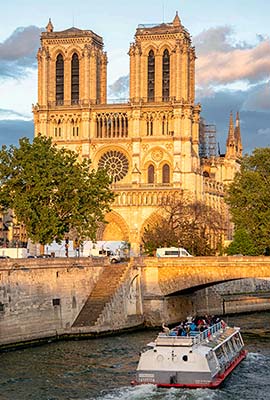
Check out the facade: Mary with the Baby Jesus (in rose window) above the 28 Kings of Judah (statues that were beheaded during the Revolution). Then wander around the exterior with its forest of frilly buttresses, watched over by a fleet of whimsical gargoyles.
During the closure, you can view the church from three spots: across the river (where you’ll find what seems like a purpose-built viewpoint between the green bookstalls); from the plaza facing the facade (worthwhile even if looking over the construction fence); and walking along the left side (where you won’t see much of the architecture, but you can follow a fascinating outdoor photo exhibit that describes the demanding restoration process in English).
For up-to-date information, see www.notredamedeparis.fr (select “Visiter”—website is in French only) or https://en.parisinfo.com/practical-paris/info/guides [URL inactive]. To experience the interior of another Gothic church that’s roughly the size of Notre-Dame, visit St. Eustache Church (listed on here).
Until Notre-Dame Cathedral reopens to visitors, an underground parking lot behind the Paris Archaeological Crypt has been transformed into a two-part exhibit that immerses visitors in the cathedral’s storied past and present; you’ll experience the church from its birth to near death. Allow 30 minutes for the free In the Heart of the Restoration exhibit and 45 minutes for the sensational Eternelle Notre-Dame virtual reality experience.
Cost and Hours: Exhibit-free; 45-minute virtual reality experience-€35, €25 for those under 18, cheaper if booked online, choose the Notre-Dame square location, not La Défense, where the same show is presented (www.eternellenotredame.com). Both the exhibit and virtual reality experience are open Tue-Sun 10:00-20:00, closed Mon.
Getting There: The entrance is 30 yards past the Archaeological Crypt (with your back to Notre-Dame’s facade)—look for blue banners.
In the Heart of the Restoration Exhibit: This exhibit features eight thematic islands dedicated to every aspect of the restoration. Screens explain the herculean task facing the workers, such as erecting 3,000 tons of scaffolding, buttressing the arches, and replacing fragile windows. Excellent information is posted in English throughout. Skip the 18-minute movie unless you have plenty of time, but don’t miss the fresco depicting the different tasks of this monumental challenge.
Eternelle Notre-Dame: This virtual reality experience, worth ▲▲, is not advised for kids under age 11 or for people with vertigo or fear of heights (though you never leave the ground and walk only a short distance).
Strapped into a high-tech day pack and virtual reality headset, you enter the medieval world of Notre-Dame as the cathedral rises more than 800 years ago, and travel through time to 2019 and the cathedral’s near demise. You’ll gaze into the nave from above, watch rose windows being assembled, and meet the cathedral’s first bishop and Eugène Viollet-le-Duc, the architect who oversaw its renovation in the 1800s. You’ll also appreciate the challenges that medieval workers faced—similar to those confronting today’s workers. Highlights of this breathtaking show include getting close to the craftspeople, staring up the spire’s hollow interior, and admiring views over Paris from the Middle Ages and today.
In this intriguing 20-minute stop you’ll wander around Roman ruins from Emperor Augustus’ reign (when this island in the Seine became the birthplace of Paris) and see rotating exhibits about the cathedral and Ile de la Cité. It’s all thoughtfully explained in English and well presented with videos and touchscreens. This (along with the Cluny Museum) gives the best view of ancient Roman Paris.
Cost and Hours: €9, covered by Museum Pass, Tue-Sun 10:00-18:00, closed Mon, enter 100 yards in front of cathedral, +33 1 55 42 50 10, www.crypte.paris.fr.
Visiting the Crypt: The first few panels put the ruins in historical context. A helpful exhibit, focusing on Ile de la Cité, gives life to the ruins standing in the middle of the museum (a confusing mix of foundations dating from the Roman town to an early, walled medieval city and the church that preceded Notre-Dame).
As you circle the ruins counterclockwise, note some highlights: Along the right side of the museum, see big stone blocks from the old Roman wall. At the back, step onto the remains of a Roman dock. Farther along, play with the touchscreen for a chance to appreciate the 200-year construction process of Notre-Dame Cathedral, and a view of the Rue Neuve ruins along the old road that led straight up to the church (and runs right down the center of the museum). On the museum’s far side, find the thermal baths and see a Roman building with “hypocaustal” heating—narrow passages pumped full of hot air to heat the room. The tour ends with a movie showing the grid-planned Roman town of Lutèce that preceded Paris.
Climb down the steps into this memorial dedicated to the 200,000 French victims of the Nazi concentration camps. As Paris disappears above you, this monument draws you into the victims’ experience. Once underground you enter a one-way hallway studded with tiny lights commemorating the dead, leading you to an eternal flame. For a small and moving exhibit about the Holocaust, don’t miss the rooms upstairs.
Cost and Hours: Free, daily 10:00-19:00, Oct-March until 17:00, may close at random times, free 45-minute audioguide and guided tours may be available; at the east tip of Ile de la Cité, behind Notre-Dame and near Ile St. Louis (Mo: Cité); +33 6 14 67 54 98.
The residential island behind Notre-Dame is known for its restaurants (see the Eating in Paris chapter), great ice cream, and shops (along Rue St. Louis-en-l’Ile).
The interior of this 13th-century chapel is a triumph of Gothic church architecture. Built to house Jesus’ Crown of Thorns, Sainte-Chapelle is jam-packed with stained-glass windows, bathed in colorful light, and slippery with the drool of awestruck tourists. Ignore the humdrum exterior and climb the stairs into the sanctuary, where more than 1,100 Bible scenes—from the Creation to the Passion to Judgment Day—are illustrated by light and glass.
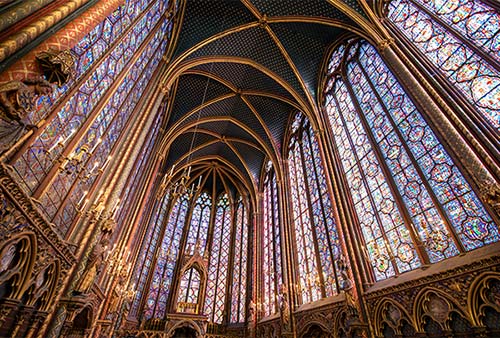
Cost and Hours: €11.50 for timed-entry ticket, €18.50 combo-ticket with Conciergerie, free for kids under age 18, covered by Museum Pass, reserve online in advance to ensure entry (limited tickets may be available in person); daily 9:00-19:00, Oct-March until 17:00; audioguide-€3, evening concerts—see here, 4 Boulevard du Palais, Mo: Cité, +33 1 53 40 60 80, www.sainte-chapelle.fr. For tips on avoiding long lines here, see here.
Marie-Antoinette was imprisoned here, as were Louis XVI, Robespierre, Danton, and many others on their way to the guillotine. Exhibits with good English descriptions trace the history of the building and give some insight into prison life.
Cost and Hours: €11.50 (timed-entry tickets available but not necessary), €18.50 combo-ticket with Sainte-Chapelle, covered by Museum Pass; daily 9:30-18:00, free multimedia guide, 2 Boulevard du Palais, Mo: Cité, +33 1 53 40 60 80, www.paris-conciergerie.fr.
Paris’ grandest park, the Tuileries Garden, was once the private property of kings and queens. Today it links the Louvre, Orangerie, and Orsay museums with the Place de la Concorde and the Champs-Elysées. And across from the Louvre are the tranquil, historic courtyards of the Palais Royal.
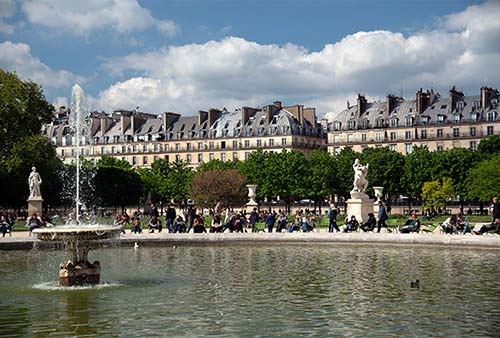
This is Europe’s oldest, biggest, greatest, and second-most-crowded museum (after the Vatican). Housed in a U-shaped, 16th-century palace (accentuated by a 20th-century glass pyramid), the Louvre is Paris’ top museum and one of its key landmarks. It’s home to Mona Lisa, Venus de Milo, and hall after hall of Greek and Roman masterpieces, medieval jewels, Michelangelo statues, and paintings by the greatest artists from the Renaissance to the Romantics.
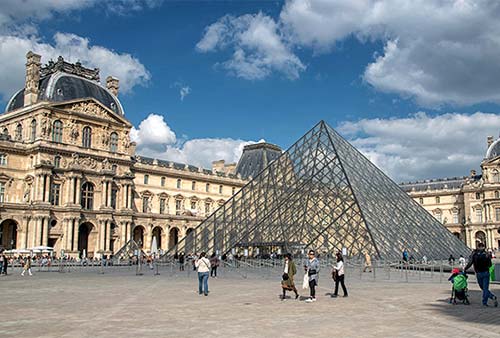
Touring the Louvre can be overwhelming, so be selective. Focus on the Denon wing, with Greek sculptures, Italian paintings (by Raphael and Leonardo), and—of course—French paintings (Neoclassical and Romantic), and the adjoining Sully wing, with Egyptian artifacts and more French paintings. For extra credit, tackle the Richelieu wing, displaying works from ancient Mesopotamia, as well as French, Dutch, and Northern art.
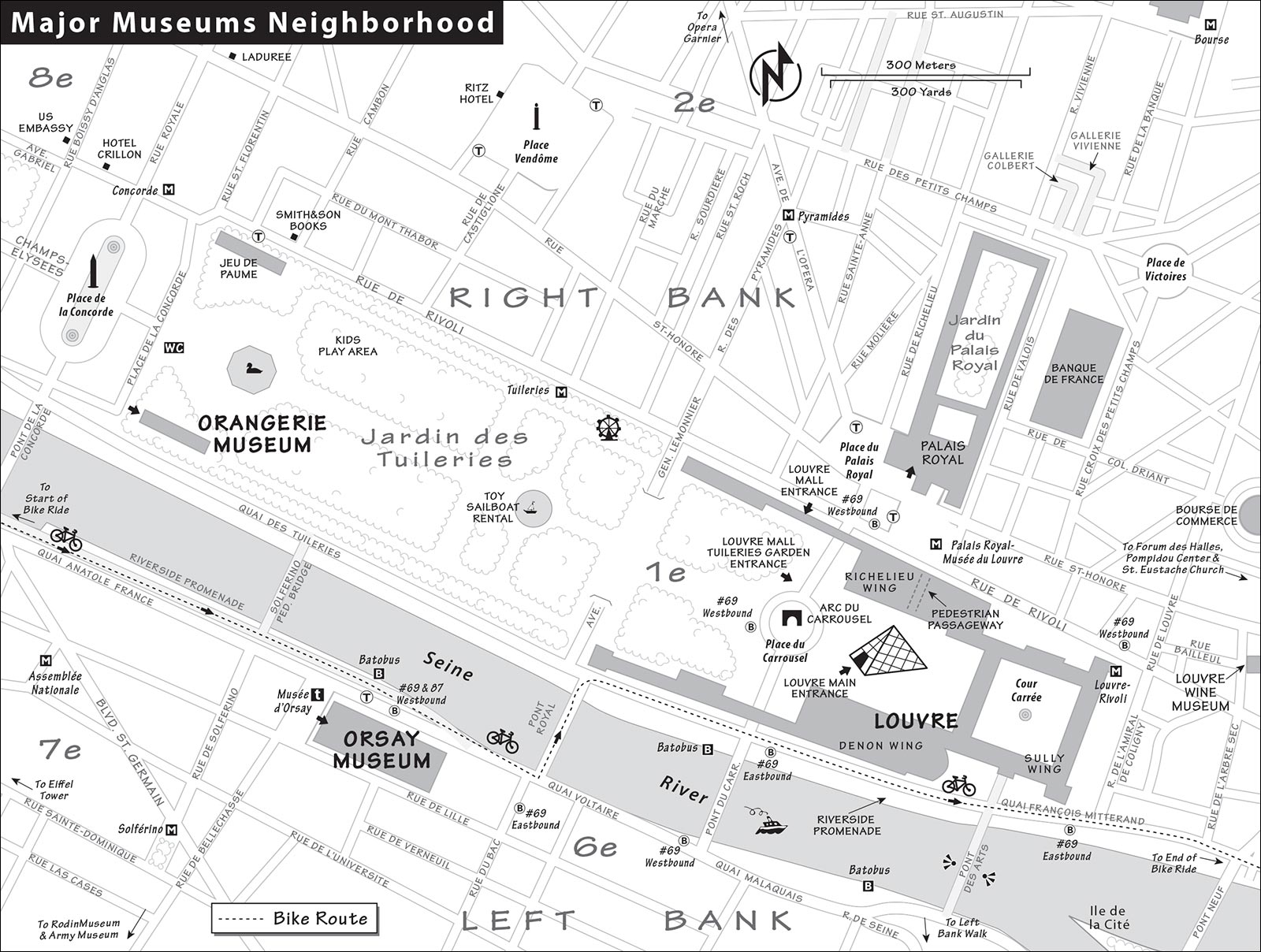
Cost and Hours: €17 for timed-entry ticket—book online in advance, includes special exhibits, covered by Museum Pass (but pass holders must reserve a time slot long in advance—it’s easier to buy an individual timed-entry ticket, as more of these are available); €15 timed-entry tickets are rarely available at the door—and you’ll wait in a long line; open Wed-Mon 9:00-18:00, until 21:45 on Fri (and possibly on Wed—check online), closed Tue, last entry 45 minutes before closing; crowds worst in the morning and all day Sun, Mon, and Wed; multimedia guide-€5, guided tours available, several cafés, +33 1 40 20 53 17, recorded info +33 1 40 20 51 51, www.louvre.fr.
Getting There: Use the Palais Royal-Musée du Louvre Métro stop. Bus #69 also runs past the Louvre.
 See the Louvre Tour chapter or
See the Louvre Tour chapter or  download my free audio tour.
download my free audio tour.
Across from the Louvre are the lovely courtyards of the stately Palais Royal. Although the palace is closed to the public, the courtyards are open.
Cost and Hours: Free and always open. The Palais Royal is directly north of the Louvre on Rue de Rivoli (Mo: Palais Royal-Musée du Louvre).
Visiting the Courtyards: Enter through a whimsical (locals say tacky) courtyard filled with stubby, striped columns and playful fountains (with fun, reflective metal balls). Next, you’ll pass into another, perfectly Parisian garden. This is where in-the-know Parisians come to take a quiet break, walk their poodles and kids, or enjoy a rendezvous—amid flowers and surrounded by a serene arcade and a handful of historic restaurants. Bring a picnic and create your own quiet break, or have a drink at one of the outdoor cafés at the courtyard’s northern end. This is Paris.
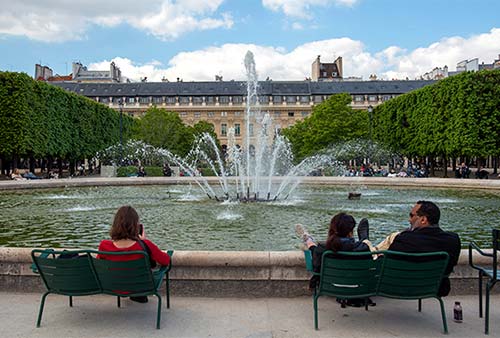
Though tranquil today, this was once a hotbed of political activism. The palace was built in the 17th century by Louis XIII and eventually became the headquarters of the powerful Dukes of Orléans. Because the Dukes’ digs were off-limits to the police, some shocking free-thinking took root here. This was the meeting place for the debating clubs—the precursors to modern political parties. During the Revolution, palace resident Philippe, duc d’Orléans, (nicknamed Philippe Egalité for his progressive ideas) advocated a constitutional monarchy, and voted in favor of beheading Louis XVI—his own cousin. Philippe hoped his liberal attitudes would spare him from the Revolutionaries, but he, too, was guillotined. His son, Louis-Philippe, became France’s first constitutional monarch (r. 1830-1848). The palace’s courtyards were backdrops for a riotous social and political scene, filled with lively café culture, revolutionaries, rabble-rousers, scoundrels, and...Madame Tussaud’s first wax shop (she used the severed heads of guillotine victims to model her sculptures).
Nearby: Exiting the courtyard at the side facing away from the Seine brings you to the Galeries Colbert and Vivienne, attractive examples of shopping arcades from the early 1800s (see here).
The Orsay boasts Europe’s greatest collection of Impressionist works. It might be less important than the Louvre—but it’s more purely enjoyable.
The Orsay, housed in an atmospheric old train station, picks up where the Louvre leaves off: the second half of the 19th century. This is art from the tumultuous time that began when revolutions swept across Europe in 1848 and ended when World War I broke out in 1914. Begin with the conservative art of the mid-1800s—careful, idealized Neoclassicism (with a few rebels mixed in). Then tour the late 1800s, when the likes of Manet, Monet, Degas, and Renoir jolted the art world with their colorful, lively invention, Impressionism. (Somewhere in there, Whistler’s Mother sits quietly.) The Orsay also displays works of their artistic descendants, the Post-Impressionists: Cézanne, Van Gogh, Gauguin, Seurat, and Toulouse-Lautrec. On the mezzanine level, waltz through Rodin sculptures and Art Nouveau exhibits, and finish in the Grand Ballroom, which shows the chandeliered elegance of this former train station.
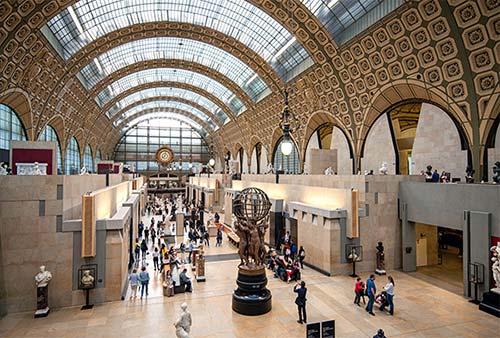
Cost and Hours: €16, free on first Sun of month (but timed-entry ticket required), covered by Museum Pass, combo-tickets with Orangerie Museum (€20) or Rodin Museum (€24)—visit these less-crowded sights first to purchase combo-ticket; keep Orsay ticket for discount at Opéra Garnier (within 5 days of Orsay visit). Museum open Tue-Sun 9:30-18:00, Thu until 21:45, closed Mon, last entry one hour before closing (45 minutes before on Thu), top-floor Impressionist galleries start shutting 45 minutes before closing; museum especially crowded on Sun and Tue; audioguide-€6, guided tours-€10; cafés and restaurant, +33 1 40 49 48 14, www.musee-orsay.fr.
Getting There: The museum, at 1 Rue de la Légion d’Honneur, sits above the RER/Train-C Musée d’Orsay stop; the nearest Métro stop is Solférino, three blocks southeast of the Orsay. Buses #69 and #87 stop near the Orsay. From the Louvre, it’s a lovely 15-minute walk through the Tuileries Garden and across the pedestrian bridge.
 See the Orsay Museum Tour chapter (which includes more tips on avoiding lines) or
See the Orsay Museum Tour chapter (which includes more tips on avoiding lines) or  download my free audio tour.
download my free audio tour.
Located in the Tuileries Garden and drenched by natural light from skylights, the Orangerie (oh-rahn-zhuh-ree) is the closest you’ll come to stepping into an Impressionist painting. Start with the museum’s claim to fame: Monet’s Water Lilies. Then head downstairs to enjoy the manageable collection of select works by Utrillo, Cézanne, Renoir, Matisse, and Picasso.
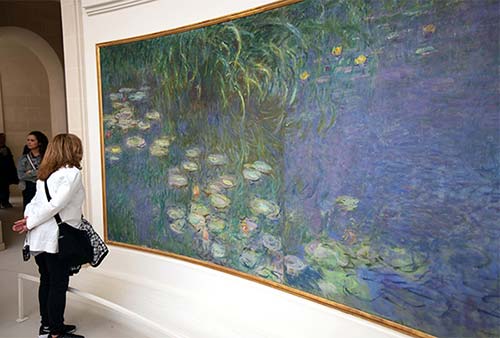
Cost and Hours: €12.50, timed-entry ticket highly recommended (buy online in advance), free for those under age 18, free on first Sun of the month (but timed-entry ticket required), €20 combo-ticket with Orsay Museum (not sold online—book a free timed-entry ticket on Orangerie website, then purchase combo-ticket at the museum), covered by Museum Pass; Wed-Mon 9:00-18:00, closed Tue; audioguide-€5, English guided tours available-€6, located in Tuileries Garden near Place de la Concorde (Mo: Concorde), 15-minute stroll from the Orsay, +33 1 44 77 80 07, www.musee-orangerie.fr.
 See the Orangerie Museum Tour chapter.
See the Orangerie Museum Tour chapter.
Today’s modern shopping mall and esplanade covers what was, since the Middle Ages, the center of all food distribution in Paris. For eight centuries, Les Halles (lay all, the halls) functioned as a gargantuan open market where fish, meats, and vegetables were sold and distributed. By the late 1800s the market was covered with muscular steel arches and looked something like Paris’ older train stations. The area buzzed 24/7—meats were butchered and fish were cleaned until late at night, farmers and fishermen arrived with their goods early in the mornings, and deals were made throughout the day. In 1971 the market was torn down: Increased traffic, smells, and higher land values had forced its relocation to near Orly Airport (in the town of Rungis).
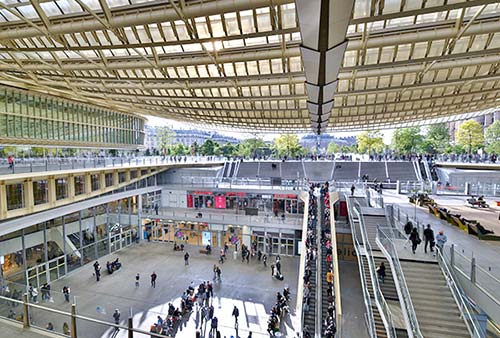
Today’s incarnation of the huge market—Forum des Halles—is a multilevel shopping center (at 101 Porte Berger, Mo: Les Halles, www.westfield.com/france). It’s famous for its canopy with louvers to maximize the shade and is designed to collect rainwater, which powers a fountain that cascades from its peak down to a babbling man-made brook. The mall is the embodiment of 21st-century urban design: It quietly rests over a massive underground transportation hub and faces a pleasant city park (with a fun kids’ zone) and esplanade. The park is overlooked by the spindly Gothic St. Eustache Church and the stately old Bourse de Commerce building, which now houses a contemporary art collection (both described next).
Nearby: Rue Montorgueil and Rue Montmartre are delightful café-lined streets a macaron toss from the shopping mall (described in the Shopping in Paris chapter).
This impressive Gothic church is a worthy alternative to Notre-Dame during the famous cathedral’s closure. Built 300 years after Notre-Dame (and similar in size), St. Eustache is a testament to the enduring appeal of the Gothic style. From the exterior, St. Eustache’s forest of flying buttresses makes Notre-Dame’s seem tame by comparison. Inside you’ll notice Renaissance details, but its Gothic style resonates. St. Eustache served the community of vendors of the once-magnificent outdoor market of Les Halles. After the market relocated in 1971, this “church of the market people” fell silent. Today, in the rear of the church, you’ll find a delightful sculpture honoring the market tradition of this neighborhood: The Departure of Fruit and Vegetables from the Heart of Paris, by Raymond Mason.
Cost and Hours: Free, Sun-Fri 9:30-19:00, Sat from 10:00, 146 Rue Rambuteau, Mo: Les Halles, +33 1 42 36 31 05, www.saint-eustache.org.
This beautiful building houses the impressive contemporary art collection of French billionaire businessman François Pinault. What was once a medieval granary became the Paris stock exchange for the 1889 World’s Fair (for which the Eiffel Tower was built). Inside (entry fee required), a painting on the dome of the vast rotunda depicts an imperialist and utopian vision of international trade in the 1800s (notice the arrival of the train and the telegraph poles). Temporary exhibitions in the museum galleries are rotated throughout the year.
Cost and Hours: €14, daily 11:00-19:00, 2 Rue de Viarmes, Mo: Les Halles, +33 1 55 04 60 60, www.pinaultcollection.com.
This scratch-and-sniff wine museum (audio or guided tours only), has engaging exhibits describing everything from terroir (the qualities that come from soil, climate, etc.) to grape varieties to corks to bottle labels. Your tour ends with a tasting of three wines).
Cost and Hours: €30 for audioguide (mornings only, no tasting), €36 two-hour guided tour daily 14:00-18:00, must book ahead; between Forum des Halles and the Louvre at 52 Rue de l’Arbre Sec, Mo: Louvre-Rivoli, +33 1 40 28 13 11, www.cavesdulouvre.com.
Built on the 100th anniversary of the French Revolution (and in the spirit of the Industrial Revolution), the tower was the centerpiece of a World Expo designed simply to show off what people could build in 1889. For decades it was the tallest structure the world had ever known, and though it’s since been eclipsed, it’s still the most visited monument. Ride the elevators to the top of its 1,063 feet for expansive views that stretch 40 miles. Then descend to the two lower levels, where the views are arguably even better, since the monuments are more recognizable.
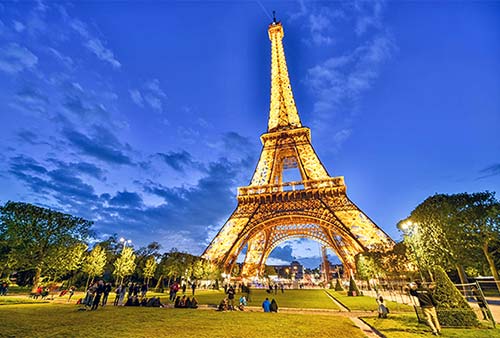
Cost and Hours: €28.30 to ride all the way to the top, €18.10 for just the two lower levels, €11.30 to climb the stairs to the first or second level, €21.50 to climb the stairs to the second level and take the elevator to the summit, 50 percent cheaper for those under 25, 75 percent cheaper for those under 12, book online in advance (see below), not covered by Museum Pass; open daily mid-June-Aug 9:00-24:45, Sept-mid-June 9:30-23:45, last ascent to top by elevator at 22:30 and to lower levels at 23:00 all year (stairs same except Sept-mid-June last ascent 18:30); cafés and great view restaurants, Mo: Bir-Hakeim or Trocadéro, RER-C: Champ de Mars-Tour Eiffel (all a 10-minute walk away). Recorded information +33 8 92 70 12 39, www.toureiffel.paris.
Reservations Smart: Make a reservation well in advance of your visit—or be ready to wait in long lines. At www.toureiffel.paris, you can book a time slot for your ascent; this allows you to skip the long initial entry line. Tickets go on sale about 60 days in advance and sell out quickly for visits from April through September, so don’t dally.
 See the Eiffel Tower Tour chapter (which includes more tips on getting in).
See the Eiffel Tower Tour chapter (which includes more tips on getting in).
This fountain-fronted square, across the river and uphill from the Eiffel Tower, delivers the greatest views of that landmark. Trocadéro’s view plaza is a circus of tourists from early to late (watch for pickpockets). The busy Pont d’Iéna bridge in front of the Eiffel Tower will eventually be traffic-free, if Paris mayor Anne Hidalgo gets her way (which she usually does).
Place du Trocadéro is named for a 19th-century battle victory by Les French over Spain and is overseen by a statue of WWI Supreme Allied Commander Ferdinand Foch on his horse. Two interesting museums, described next, flank the plaza as wings of the curved Palais de Chaillot, built for the 1937 World’s Fair.
This kid-friendly museum (recently closed for renovation but should reopen by the time you visit) anchors a dazzling collection of ship and submarine models, torpedoes, cannonballs, beaucoup bowsprits, and naval you-name-it. Enjoy the full-sized party barge made for Napoleon in 1810 and look up at the elaborate stern of the 1694 Réale de France royal galley (don’t miss the scale model). Exhibits describe ship construction, from Roman vessels to modern cruise ships to aircraft carriers.
Cost and Hours: Likely about €12, may include audioguide, free for those age 26 and under, should be covered by Museum Pass; expected hours (but check ahead)—Wed-Mon 11:00-18:00, Sat-Sun until 19:00, closed Tue; on left side of Place du Trocadéro with your back to Eiffel Tower, tel. +33 1 53 65 69 69, www.musee-marine.fr.
This museum, on the east side of Place du Trocadéro, takes you through 1,000 years of French architecture, starring some of France’s greatest Gothic churches—all brought to life through full-sized casts and scale models. Intriguing exhibits covering the fire at Notre-Dame should be on display through 2024.
Cost and Hours: €9, covered by Museum Pass, free on first Sun of the month; open Wed-Mon 11:00-19:00, Thu until 21:00, closed Tue; helpful audioguide-€5, 1 Place du Trocadéro, Mo: Trocadéro, RER/Train-C: Champ de Mars-Tour Eiffel, +33 1 58 51 52 00, www.citechaillot.fr.
Visiting the Museum: Pick up the museum plan, augment it with the English info posted in many rooms, and focus most of your time on the ground floor. Walk the length of the floor, passing under tympanum arches and pondering how many ways you can envision the Last Judgment (exhibits about the Notre-Dame fire are scattered throughout). Gaze into the eyes of medieval statues from Cluny Abbey, Chartres Cathedral, Château de Chambord, and much more. A U-turn at the end of the hall leads to the Renaissance and the screaming passion of the Revolution.
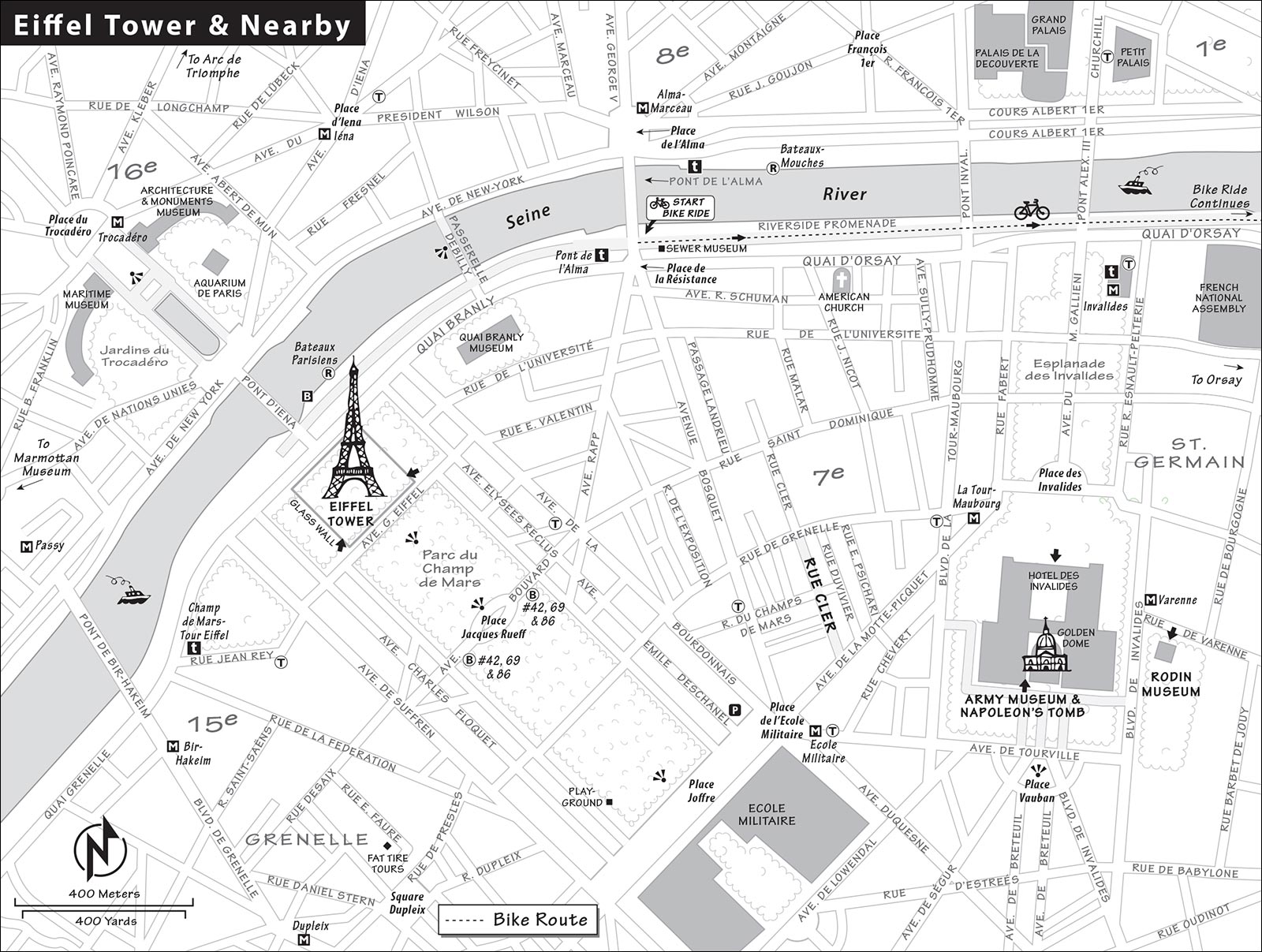
Take the elevator up a floor (level N-2) to see thought-provoking designs for modern projects, including sports arenas, suspension bridges, and low-income housing. You can walk into a room from Le Corbusier’s 1952 Habitation Unit from Marseille and appreciate what a forward thinker he was. Farther along, you’ll see how colorfully painted the chapels were in medieval churches. The views to the Eiffel Tower are sensational. The attached café makes for a classy break in your sightseeing, with more views of the Eiffel Tower.
This is the best collection I’ve seen anywhere of non-Western art from Africa, Oceania, Asia, and the Americas. Viewing this collection offers a richer appreciation of traditions from around the world. The exhibits are presented in a wild, organic, and strikingly modern building. It’s well worth a look, particularly if you have a Museum Pass and are near the Eiffel Tower.
Cost and Hours: €12, free on first Sun of the month, covered by Museum Pass; museum—Tue-Sun 9:30-19:00, Thu-Sat until 22:00, closed Mon, ticket office closes one hour before closing; gardens—Tue-Sun 9:15-19:30, Thu-Sat until 21:15, closed Mon; audioguide-€5, 37 Quai Branly, 10-minute walk east (upriver) of Eiffel Tower, along the river, RER/Train-C: Champ de Mars-Tour Eiffel or Pont de l’Alma, +33 1 56 61 70 00, www.quaibranly.fr.
Visiting the Museum: Don’t stand in the ticket line if you have a pass or online ticket; the museum entry is around the left side of the building from the ticket booth. After passing the security check and the ticket taker, pick up the museum map, then follow a ramp upstream along a projected river of the 1,657 names of the peoples covered in the museum. The permanent collection occupies the first floor up, covering five continents. (Most compelling is the Oceania section, which includes 200 works from New Guinea to New Zealand and from Easter Island to Hawaii). You’ll see masks, statuettes, musical instruments, textiles, clothes, totems, voodoo dolls, and much more, all artfully presented and exquisitely lit. Look also for descriptions of the challenges these cultures face. There’s no need to follow a route: Wander at whim. Helpful English explanations are posted in most rooms (look hard to find them) and provide sufficient description for most visitors, though serious students will want to rent the audioguide.
Eiffel Tower Views: Even if you skip the museum, drop by its peaceful garden Café Jacques for fine Eiffel Tower views and enjoy the intriguing gardens. The pedestrian bridge that crosses the river and runs up to the museum also has sensational tower views.
Discover what happens after you flush. This quick, interesting, and slightly stinky visit (a perfumed hanky helps) takes you along a few hundred yards of water tunnels in the world’s first underground sewer system.
Cost and Hours: €9, free entry for those under 18, not covered by Museum Pass; Tue-Sun 10:00-17:00, closed Mon, last entry one hour before closing; located where Pont de l’Alma greets the Left Bank—on the right side of the bridge as you face the river, Mo: Alma-Marceau, RER/Train-C: Pont de l’Alma, +33 1 53 68 27 81, www.musee-egouts.paris.fr/en [URL inactive].
Visiting the Sewer: With nary a word in English throughout the museum, the loaner booklet and map are essential (available at the entry). You can also scan the QR code at the entrance for more information, then drop down into Jean Valjean’s world of tunnels, rats, and manhole covers. (Victor Hugo was a friend of the sewer inspector when he wrote Les Misérables.) Well-organized displays explain the history of water distribution and collection in Paris, from Roman times to the present.
Sens de la Visite (“direction of visit”) signs and numbered stops guide you along open sewers and through exhibits that explain the evolution of this amazing network of sewers. More than 1,500 miles of tunnels carry 317 million gallons of water daily through this underworld. It’s the world’s longest sewer system—so long, they say, that if it were laid out straight, it would stretch from Paris all the way to Istanbul.
It’s enlightening to see how much work goes into something we take for granted. Sewage didn’t always disappear so readily. In the Middle Ages, wastewater was tossed from windows to a center street gutter, then washed into the river (which also supplied locals’ drinking water). In castles, sewage ended up in the moat (enhancing the moat’s defensive role). In the 1500s, French Renaissance King François I moved from château to château (he had several) when the moat-muck became too much. The museum illustrates how, over time, sewage became separated from drinking water and explains the intricate systems in place today that sustain that separation.
Paris is always changing, but a stroll down this market street introduces you to a thriving, traditional Parisian neighborhood and offers insights into the local culture. Although this is a wealthy district, Rue Cler retains the workaday charm still found in most neighborhoods throughout Paris. The shops lining the street are filled with the freshest produce, the stinkiest cheese, the tastiest chocolate, and the finest wines (markets generally open Tue-Sat 8:30-13:00 & 15:00-19:30, Sun 8:30-12:00, dead Sun afternoon and Mon). I’m hardly a gourmet eater, but my time spent tasting my way along Rue Cler has heightened my appreciation of good cuisine (as well as the French knack for good living).
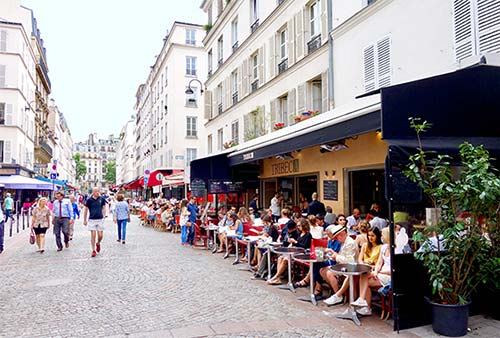
 See the Rue Cler Walk chapter or
See the Rue Cler Walk chapter or  download my free audio tour.
download my free audio tour.
Europe’s greatest military museum, in the Hôtel des Invalides, provides worthwhile coverage of several wars, particularly World Wars I and II. At the center of the complex, Napoleon lies majestically dead inside several coffins under a grand dome—a goose-bump inducing pilgrimage for historians. The dome overhead glitters with 26 pounds of thinly pounded gold leaf.
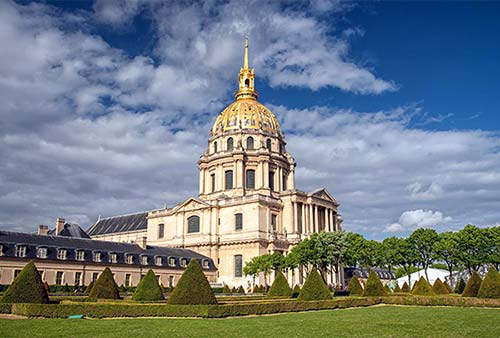
Cost and Hours: €15, free for military personnel in uniform, free for kids but they must wait in line for ticket, covered by Museum Pass; daily 10:00-18:00, Napoleon’s Tomb until 22:00 on the first Fri of the month (€10 entry after 18:00); multimedia guide-€5, cafeteria, +33 1 44 42 38 77, www.musee-armee.fr. A sound-and-light show runs at Les Invalides on summer nights (see here).
Getting There: The Hôtel des Invalides is at 129 Rue de Grenelle, a 10-minute walk from Rue Cler (Mo: La Tour-Maubourg, Varenne, or Invalides). You can take bus #69 (from the Marais and Rue Cler) or bus #6 from the St. Germain-des-Prés area. Buses #82 or #92 also take you there.
 See the Army Museum & Napoleon’s Tomb Tour chapter.
See the Army Museum & Napoleon’s Tomb Tour chapter.
This user-friendly museum with gardens is filled with passionate works by Auguste Rodin (1840-1917), the greatest sculptor since Michelangelo. You’ll see The Kiss, The Thinker, The Gates of Hell, and many more, well displayed in the mansion where the sculptor lived and worked. Exhibits trace Rodin’s artistic development, explain how his bronze statues were cast, and show some of the studies he created to work up to his masterpiece, the unfinished Gates of Hell. Learn about Rodin’s tumultuous relationship with his apprentice and lover, Camille Claudel. Mull over what makes his sculptures some of the most evocative since the Renaissance. And stroll the beautiful gardens, packed with many of his greatest works (including The Thinker) and ideal for artistic reflection.
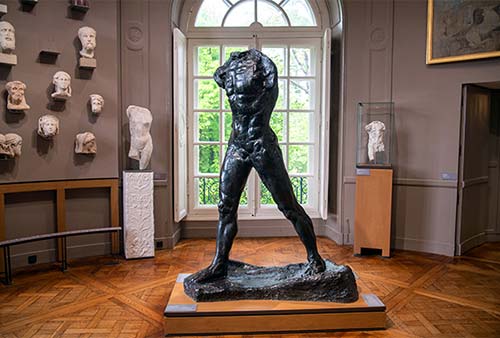
Cost and Hours: €13, free for those under age 18, free on first Sun of the month Oct-March, €24 combo-ticket with Orsay Museum (smart to buy at this less-crowded sight), both museum and garden covered by Museum Pass; Tue-Sun 10:00-18:30, closed Mon, Oct-March garden closes at dusk; audioguide-€6, mandatory baggage check, self-service café in garden, 77 Rue de Varenne, Mo: Varenne, +33 1 44 18 61 10, www.musee-rodin.fr.
 See the Rodin Museum Tour chapter.
See the Rodin Museum Tour chapter.
In this private, intimate, and untouristy museum, you’ll find the best collection anywhere of works by Impressionist headliner Claude Monet. Follow Monet’s life through more than a hundred works, from simple sketches to the Impression: Sunrise painting that gave his artistic movement its start—and a name. The museum also displays some of the enjoyable large-scale canvases featuring the water lilies from his garden at Giverny.
Cost and Hours: €14.50, not covered by Museum Pass, €25 combo-ticket with Monet’s garden and house at Giverny (see here; lets you skip the line at Giverny); Tue-Sun 10:00-18:00, Thu until 21:00, closed Mon; audioguide-€4 (includes temporary exhibits), 2 Rue Louis-Boilly, Mo: La Muette, +33 1 44 96 50 33, www.marmottan.fr.
 See the Marmottan Museum Tour chapter.
See the Marmottan Museum Tour chapter.
This Left Bank neighborhood, immediately across the river from Notre-Dame, was the center of Roman Paris. But the Latin Quarter’s touristy fame relates to its intriguing, artsy, bohemian character. This was perhaps Europe’s leading university district in the Middle Ages, when Latin was the language of higher education. The neighborhood’s main boulevards (St. Michel and St. Germain) are lined with cafés—once the haunts of great poets and philosophers, now the hangouts of tired tourists. Though still youthful and artsy, much of this area is touristy and filled with cheap North African eateries. Exploring a few blocks up or downriver reveals the pulse of what survives of Paris’ classic Left Bank.
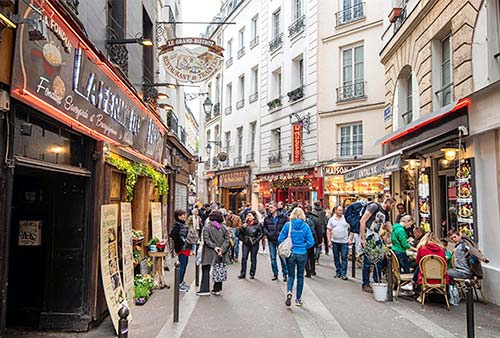
 See the Left Bank Walk chapter.
See the Left Bank Walk chapter.
This treasure trove of Middle Ages (Moyen Age) art delivers close-up looks at stained glass, Notre-Dame carvings, fine goldsmithing and jewelry, and rooms of tapestries. The star here is the exquisite series of six Lady and the Unicorn tapestries: A delicate, as-medieval-as-can-be noble lady introduces a delighted unicorn to the senses of taste, hearing, sight, smell, and touch.
Cost and Hours: €12, free on first Sun of the month, covered by Museum Pass; Tue-Sun 9:30-18:15, first and third Thu of the month until 21:00, closed Mon, last entry 45 minutes before closing; near corner of Boulevards St. Michel and St. Germain at 6 Place Paul Painlevé; Mo: Cluny La Sorbonne, St-Michel, or Odéon; +33 1 53 73 78 10, www.musee-moyenage.fr.
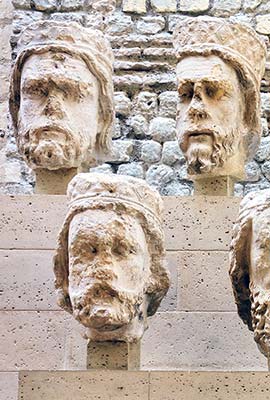
 See the Cluny Museum Tour chapter.
See the Cluny Museum Tour chapter.
A church was first built on this site in AD 558. The church you see today was constructed in 1163 and is all that’s left of a once sprawling and influential monastery. The colorful interior reminds us that medieval churches were originally painted in bright colors. The surrounding area hops at night with venerable cafés, fire-eaters, mimes, and scads of artists.
Cost and Hours: Free, daily 8:00-19:45, Mo: St-Germain-des-Prés.
For more on St. Germain-des-Prés, see here.
St. Sulpice’s impressive Neoclassical arcaded facade, with two round, half-finished towers, is modeled on St. Paul’s in London. It has a remarkable organ and offers Sunday-morning recitals.
Cost and Hours: Free, daily 8:00-19:30, Mass Sun at 11:00, Mo: St-Sulpice or Mabillon. See www.aross.fr/en for info on special concerts.
Sunday Organ Recitals: The Grand Orgue (Great Organ) at St. Sulpice Church has a rich history that boasts a succession of 12 world-class organists—including Charles-Marie Widor and Marcel Dupré—that goes back 300 years. You can hear the organ played before Sunday Mass during the audition (10:00-10:30) and during the prelude (10:45), and at 18:30; come appropriately dressed. The audition at 10:00 is a high-powered recital, sometimes performed by retired organist Daniel Roth.
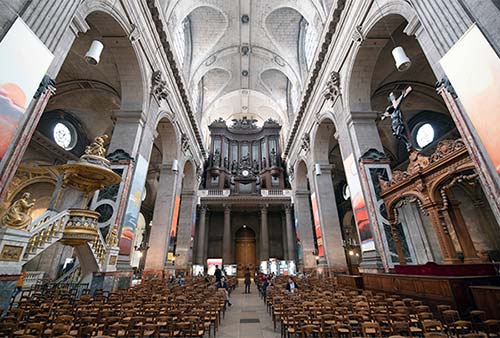
Visiting the Church: Enter the church and circle counterclockwise, making a few stops. In the first chapel on the right, find Delacroix’s three murals (on the chapel’s ceiling and walls) of fighting angels, completed during his final years while he was battling a lengthy illness. They sum up his long career, from Renaissance/Baroque roots to furious Romanticism to proto-Impressionism.
The most famous is the agitated Jacob Wrestling the Angel. The two grapple in a leafy wood that echoes the wrestlers’ rippling energy. Jacob fights the angel to a standstill, bringing him a well-earned blessing for his ordeal. Figures to the right of the tree roots include the shepherd Laban and his daughter Rachel (Jacob’s future wife). Get close and notice the thick brushwork that influenced the next generation of Impressionists—each leaf is a single brushstroke, often smudging two different colors in a single stroke. The “black” of the piled clothes in the foreground—notice the French flag among them—is built from rough strokes of purple, green, and white. (Too much glare? Take a couple of steps to the right to view it.)
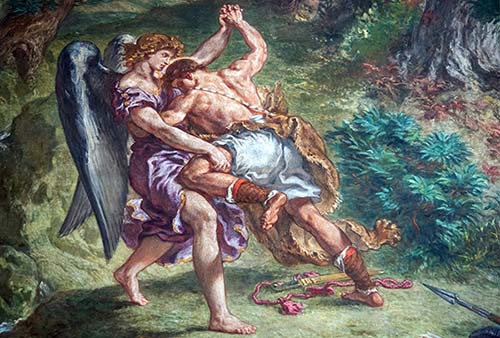
On the opposite wall, Heliodorus Chased from the Temple has the smooth, seamless brushwork of Delacroix’s prime. After Syrian Heliodorus has killed the king and launched a coup, he has entered the sacred Jewish Temple in Jerusalem in an attempt to steal the treasure. Angry angels launch themselves at him, sending him sprawling. The vibrant, clashing colors, swirling composition, and over-the-top subject are trademark Delacroix Romanticism. On the ceiling, The Archangel Michael drives demons from heaven.
Walking up the right side of the church, pause at the fourth chapel, with a statue of Joan of Arc and wall plaques listing hundreds upon hundreds of names. These are France’s WWI dead—from this congregation alone.
In the chapel at the far end of the church, behind the altar, ponder the cryptic symbolism of Mary and Child lit by a sunburst, standing on an orb, and trampling a snake, while a stone cloud tumbles down to a sacrificial lamb.
Continue around the church. On the wall of the north transept is an Egyptian-style obelisk used as a gnomon, or part of a sundial. At Christmas Mass, the sun shines into the church through a tiny hole—opposite the obelisk, high up on the south wall (in the upper-right window pane). The sunbeam strikes a mark on the obelisk that indicates the winter solstice. Then, week by week, the sunbeam moves down the obelisk and across the bronze rod in the floor, until, at midsummer, the sun lights up the area near the altar. (For a while, this corner of the church was busy with fans of The Da Vinci Code.)
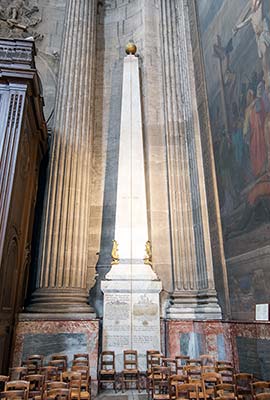
In the final chapel before the exit, there’s a copy of the Shroud of Turin (the original is in Turin, Italy). This famed burial cloth is purported to have wrapped the body of Christ, who left it with a mysterious, holy stain of his image.
Nearby: Tempting boutiques surround the church (see the Shopping in Paris chapter), and Luxembourg Garden is close by.
This quaint and quiet museum celebrating the Romantic artist Eugène Delacroix (1798-1863) was once his home and studio. A friend of bohemian artistic greats—including George Sand and Frédéric Chopin—Delacroix is most famous for his monumental painting of flag-waving Liberty Leading the People (displayed at the Louvre). He moved to this studio in 1857 to be within walking distance of St. Sulpice Church (described earlier), where he was furiously working on its chapel of St. Agnes.
Cost and Hours: €7, free on first Sun of the month, covered by Museum Pass; Wed-Mon 9:30-17:30, first Thu of the month until 21:00, closed Tue; 6 Rue de Furstenberg, Mo: St-Germain-des-Prés, +33 1 44 41 86 50, www.musee-delacroix.fr.
Visiting the Museum: The tiny museum—with a few of Delacroix’s paintings and a smattering of memorabilia—is three rooms on one floor in the main building, the artist’s studio in back, and his oasis-like garden. Most rooms have good posted explanations in English.
Delacroix’s living room is decorated with original furniture and paintings. The bedroom (with fireplace) is where Delacroix died in 1863, nursed by his longtime servant, Lucile Virginie “Jenny” Le Guillou (her portrait may be on display). Look for Delacroix’s small worktable (where he kept his paints). Outside is his small-but-peaceful walled garden where you can visit his studio (atelier).
Delacroix built the studio to his own specifications, with high ceilings, big windows, and a skylight, ideal for an artist working prior to electric lights. It’s easy to imagine him working at his easel. While there are a few “permanent” paintings here, the collection is shuffled annually. Still, you’ll always find good examples of his dramatic style in paintings and sketches. Some of Delacroix’s most popular works were book illustrations (lithographs for Goethe’s Faust, Revolutionary history, and Shakespeare). Admire Delacroix’s artistic range—from messy, colorful oils to meticulously detailed lithographs.
For more on Delacroix’s life, see here.
This lovely 60-acre garden is an Impressionist painting brought to life. Slip into a green chair pondside, enjoy the radiant flower beds, go jogging, play tennis or basketball, sail a toy sailboat, or take in a chess game or puppet show. Some of the park’s prettiest (and quietest) sections lie around its perimeter. Notice any pigeons? The story goes that a very poor Ernest Hemingway used to hand-hunt (read: strangle) them here.
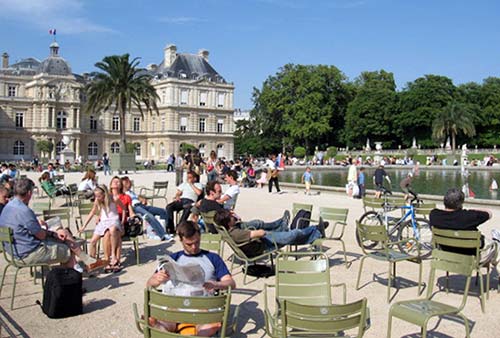
Cost and Hours: Free, daily dawn until dusk, Mo: Odéon, RER/Train-B: Luxembourg.
For more on the garden and nearby sights, see here. Also see the Paris with Children chapter for kid-friendly activities in the garden and the Left Bank Walk chapter for café recommendations.
Other Parks: If you enjoy Luxembourg Garden and want to see more green spaces, you could visit the more elegant Parc Monceau (Mo: Monceau), the colorful Jardin des Plantes (Mo: Jussieu or Gare d’Austerlitz, RER/Train-C: Gare d’Austerlitz), the Tuileries Garden (between the Louvre and Place de la Concorde, Mo: Concorde or Tuileries), or the hilly and bigger Parc des Buttes-Chaumont (Mo: Buttes-Chaumont).
This state capitol-style Neoclassical monument celebrates France’s illustrious history and people, balances a Foucault pendulum, and is the final resting place of many French VIPs.
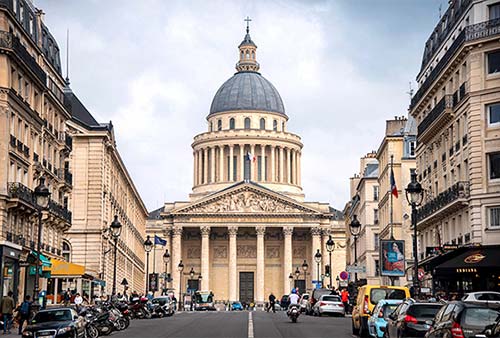
In 1744, an ailing King Louis XV was miraculously healed by Ste. Geneviève, the city’s patron saint, and he thanked her by replacing her ruined church with a more fitting tribute. By the time the church was completed (1791), however, the secular-minded Revolution was in full swing, and the church was converted into a nonreligious mausoleum honoring the “Champions of French liberty”: Voltaire, Rousseau, and others. On the entrance pediment (inspired by the ancient Pantheon in Rome), the Revolutionaries carved the inscription, “To the great men of the Fatherland.” The audioguide is worthwhile for a longer description of the many painted scenes.
Cost and Hours: €11.50, free for those under age 18, covered by Museum Pass, separate fee for dome climb (see below); daily 10:00-18:30, Oct-March until 18:00, last entry 45 minutes before closing; audioguide-€3, Mo: Cardinal Lemoine, +33 1 44 32 18 00, www.paris-pantheon.fr.
Dome Climb: From April through October you can climb 203 steps to the colonnade at the base of the dome for views of the interior and a 360-degree view of the city. You’re not so much high above Paris—it feels like you’re in the middle of it. Buy your “panorama” ticket as you enter the Panthéon or online (Museum Pass holders must buy the “panorama” ticket on site). Panorama signs direct you to the stairs (€3.50 for dome climb, not covered by Museum Pass, last entry at 16:30, visiting in the morning helps avoid ticket lines). Allow about 40 minutes for your visit.
 Self-Guided Tour: Stand on the white-and-gray star bust at the head of the 1 nave and take in the vast, evenly lit space—360 feet long, 280 feet wide, and 270 feet high. Most of the paintings and statues you see date from the 19th century. On the left wall, find the mural of Ste. Geneviève dressed in white, saving the fledgling city from Attila the Hun, the event that marks the birth of an independent Paris. When Geneviève died (AD 512), she was buried here atop what was at the time the city’s highest hill (elevation 200 feet). When Louis XV rebuilt her church to make the domed structure we see today (1791), her relics were placed directly beneath the dome. Even when Revolutionaries stripped the church of Christian elements and publicly burned Geneviève’s relics, the French still honored Geneviève as their champion. You can see Geneviève immortalized in the frescoed dome and in the mosaic over the altar wall—always depicted as the lady in white.
Self-Guided Tour: Stand on the white-and-gray star bust at the head of the 1 nave and take in the vast, evenly lit space—360 feet long, 280 feet wide, and 270 feet high. Most of the paintings and statues you see date from the 19th century. On the left wall, find the mural of Ste. Geneviève dressed in white, saving the fledgling city from Attila the Hun, the event that marks the birth of an independent Paris. When Geneviève died (AD 512), she was buried here atop what was at the time the city’s highest hill (elevation 200 feet). When Louis XV rebuilt her church to make the domed structure we see today (1791), her relics were placed directly beneath the dome. Even when Revolutionaries stripped the church of Christian elements and publicly burned Geneviève’s relics, the French still honored Geneviève as their champion. You can see Geneviève immortalized in the frescoed dome and in the mosaic over the altar wall—always depicted as the lady in white.
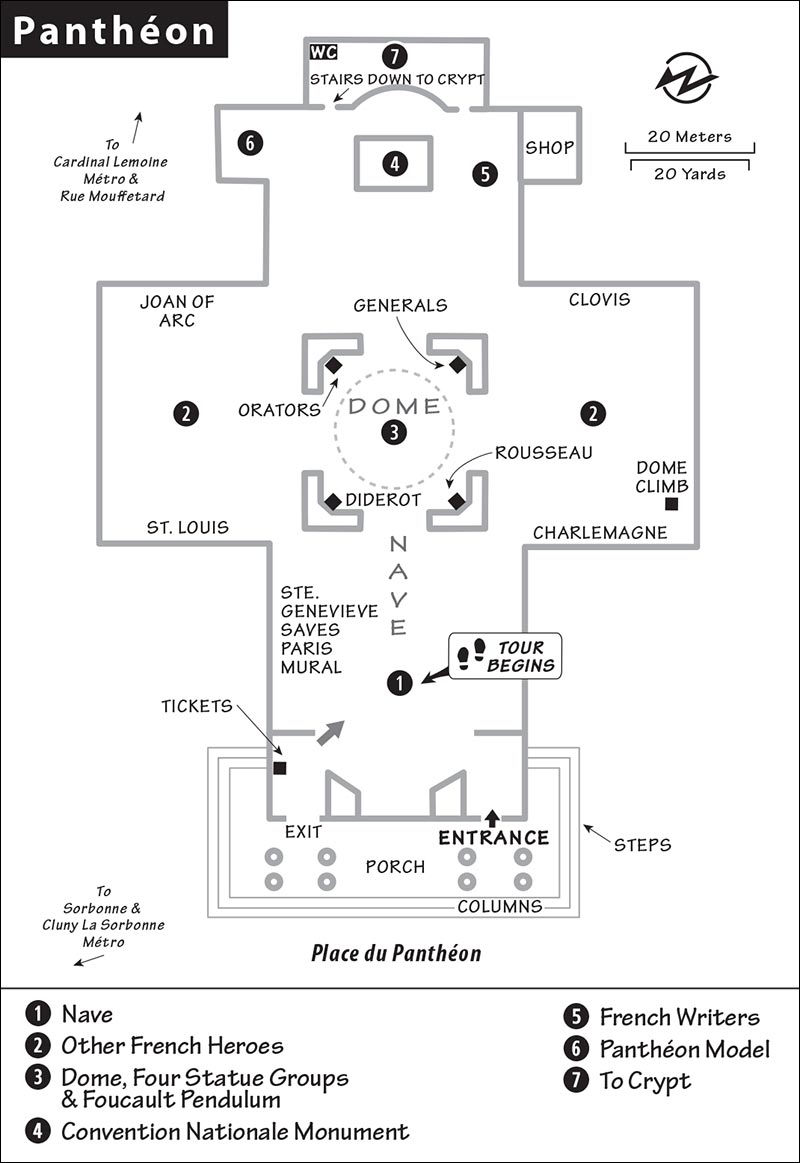
The Panthéon’s murals also honor 2 other French heroes. In the right transept (left wall) is Clovis, the father of the Franks and contemporary of Geneviève. He’s the guy in winged helmet and Asterix-style mustache amid the chaos of battle, having a vision of Christ that leads him to victory. In the far-right panel, he prepares to be baptized a Christian (and was subsequently buried here on Geneviève’s hill).
On the opposite wall is Charlemagne being crowned Emperor of the Franks (c. 800), marking the symbolic birth of France.
In the left transept (right wall) are scenes of Joan of Arc, who rallied the French in the 1420s to rid the country of the English, and was then burnt at the stake (far left).
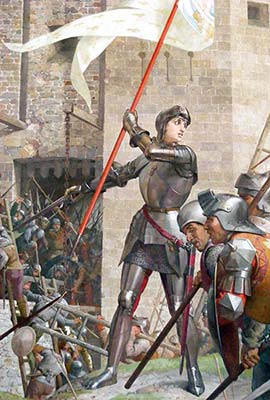
Return to the nave. The 15,000-ton 3 dome is made of a core of iron ribs covered with stone. Under the dome stand four statue groups that mark the next phase of French history, the Revolution. Check them out counterclockwise: Denis Diderot created the Encyclopédie that championed secular knowledge. Jean-Jacques Rousseau promoted the idea of a social contract between government and the people. Napoleon (on horseback) is surrounded by his generals. The Restoration is a statue of orators and bureaucrats who served the state as it sorted through the tumult of the Revolution and Napoleonic era and finally restored the monarchy—but this time kings were somewhat limited by a constitution.
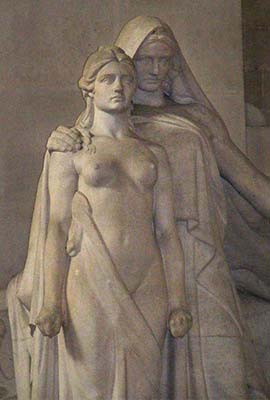
A Foucault pendulum swings gracefully at the end of a cable suspended from the towering dome. It was here in 1851 that the scientist Léon Foucault first demonstrated the rotation of the earth. The great length of the cable (220 feet) produces a slow enough oscillation to make the rotation more obvious. Stand a few minutes and watch the pendulum’s arc appear to shift as you and the earth rotate beneath it. It’s easier to visualize if you picture the pendulum suspended directly above the North Pole, with the earth spinning beneath it. Every time the pendulum swings back to the same spot, the earth will have shifted. The pendulum can also be used to tell time: Check your watch against the 24-hour dial that surrounds the pendulum.
At the altar end of the church stands the massive 4 Convention Nationale Monument. “Marianne,” the fictional woman who symbolized the Revolution, stands in the center, flanked by soldiers who fight for her and citizens who pledge allegiance to her. The inscription below reads “Live free or die.” Marianne embodies liberty, reason, and the nation of France. Above her is a mosaic in which Christ (accompanied by Geneviève and Joan of Arc) seems to give his blessing. From Geneviève to Joan of Arc to Marianne, France has always incarnated its national spirit in the female form.
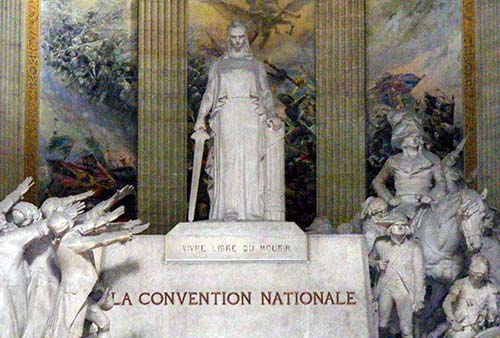
To the right of the monument, 5 French writers who died during the two world wars have their names inscribed onto the walls.
To the far left of the monument is a room displaying a 6 model of the Panthéon. This cross-section model allows you to look inside and see the structural elements. The dome is actually made of three domes-within-a-dome, and it’s supported by flying buttresses. Also, notice that there’s no patriotic inscription over the entrance, as the model was built before the Revolution.
A staircase behind the monument leads down to the 7 crypt, where a panoply of greats is buried. Rousseau is along the right wall as you enter, while Voltaire faces him impishly from across the hall. Behind Voltaire is Soufflot (the architect who built the Panthéon). Straight ahead up a few steps and through the small central rotunda are more greats (all to the left): Victor Hugo (Les Misérables, The Hunchback of Notre-Dame), Alexandre Dumas (The Three Musketeers, The Count of Monte Cristo), and Louis Braille (who invented the script for the blind). Double back to the central rotunda and turn left to find scientist Marie Curie (follow the glow), and various WWII dead (from Holocaust victims to the hero of the Resistance, Jean Moulin). You’ll also find American-born singer/entertainer—and WWII spy for the Allies—Josephine Baker, who’s adored by the French and was inducted here in 2021 (she remains buried in Monaco). Baker is the first Black woman, and first American, to be honored at the Panthéon. This building is a fitting monument to those who’ve forged France’s freedom and defended freedom of thought.
This sadly out-of-place 59-story superscraper does have its virtues: If you can’t make it up the Eiffel Tower, the sensational views from this tower are cheaper, far easier to access (a 40-second elevator ride), and make for a fair consolation prize.
Cost and Hours: €15 for tower, RS%—30 percent discount (2 people per book), not covered by Museum Pass; daily 9:30-23:30, Oct-March 10:00-22:30; entrance on Rue de l’Arrivée, Mo: Montparnasse-Bienvenüe—from the Métro, stay inside the station and follow signs to exit #1, +33 1 45 38 52 56, www.tourmontparnasse56.com.
Fine Dining with a View: The tower has a recommended restaurant, $$$$ Le Ciel de Paris, with a view bar that is free to access. The restaurant faces west, with the Eiffel Tower dead center; book your dinner ahead or just show up for a reasonably priced drink—easiest before or after the 19:00-21:00 dinner crunch (+33 1 40 64 77 64, www.cieldeparis.com).
Visiting the Tower: Come early in the day for the clearest skies and shortest lines and be treated to views from a comfortable interior (consider their breakfast with a view). Sunset is great, but views are disappointing after dark, except when the Eiffel Tower erupts in light every hour. Some say it’s the very best view in Paris, as you can see the Eiffel Tower...and you can’t see the Montparnasse Tower. The rooftop terrace is closed until further notice.
Find the elevator entrance near the skyscraper’s main entry on the northwest side of the tower (with the train station to your back, it’s around to the left side of the building). Exit the elevator at the 56th floor to buy your ticket (the view restaurant is the other direction off the elevator). Here you can marvel at the views of tout Paris (good even if cloudy), have a light meal (reasonable prices in the small cafeteria), and peruse the gift shop.
To identify all the highlights of the star-studded vista, scan the QR codes. Find the southeast view straight ahead as you enter, with Montparnasse Cemetery just below and beautiful Luxembourg Garden off to the left a bit. Locate the tall towers of the St. Sulpice Church and Notre-Dame farther in the distance. Moving counterclockwise, look northwest over the impossibly long structure of the Louvre, and the glittering dome of Les Invalides. Next, you’ll see a sensational view of the Champ de Mars park looking like a red carpet leading up to the Eiffel Tower. Behind that are the skyscrapers of La Défense. From this vantage, it’s easy to admire Baron Georges-Eugène Haussmann’s grand-boulevard scheme (see the sidebar later in this chapter). Notice the lush courtyards hiding behind magnificent street fronts.
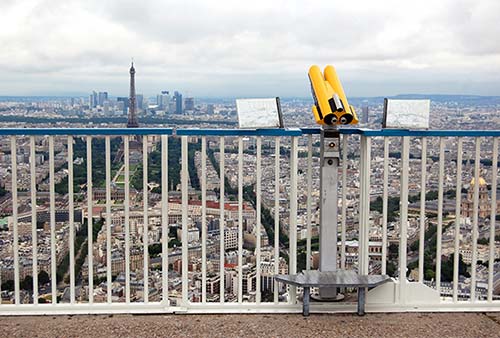
Sightseeing Tip: The tower is an efficient stop when combined with a day trip to Chartres, which begins at the Montparnasse train station (see the Chartres chapter).
Spiral down 60 feet below the street and walk a one-mile route through tunnels containing the anonymous bones of six million permanent Parisians. Once inside, allow an hour if you dawdle.
Cost and Hours: €29 for timed-entry ticket, book online in advance, includes audioguide, not covered by Museum Pass; ticket office open Tue-Sun 9:45-19:30, closed Mon; €18 same-day tickets sometimes available online or, if you’re very lucky, at the door; otherwise consider Fat Tire Tours’ pricey “Skip the Line” tour (see here); +33 1 43 22 47 63, www.catacombes.paris.fr.
Getting There: It’s at 1 Place Denfert-Rochereau. Take the Métro to Denfert-Rochereau and follow Sortie 1 signs; it’s right across the street as you exit. If you have trouble, find the lion in the big traffic circle; if he looked left rather than right, he’d stare right at the green entrance to the Catacombs.
Background: In 1785, health-conscious Parisians looking to relieve congestion and improve the city’s sanitary conditions emptied the church cemeteries and moved the bones here, to former limestone quarries where, incidentally, plaster of Paris was made. Then, in the mid-19th century, Baron Haussmann’s many urban projects required the relocation of cemeteries, and these ancient, hand-dug quarries fit the bill. For decades, priests led ceremonial processions of black-veiled, bone-laden carts into the quarries, where the bones were stacked in piles five feet high and as much as 80 feet deep.
Visiting the Catacombs: You’ll descend 130 steps and land in a room with English posters describing 45 million years of ancient geology, then walk for 10 minutes through tunnels to reach the bones. Appreciate that some of these tunnels were originally built sans mortar. The sign, “Halt, this is the empire of the dead,” announces your arrival at the bones. From here, shuffle along passageways of artfully arranged, skull-studded tibiae; admire 300-year-old sculptures cut into the walls of the catacombs; and see more cheery signs: “Happy is he who is forever faced with the hour of his death and prepares himself for the end every day.” The highlight for me is the Crypt of the Passion (a.k.a. “the Barrel”), where bones are meticulously packed in a barrel shape hiding a support pillar.
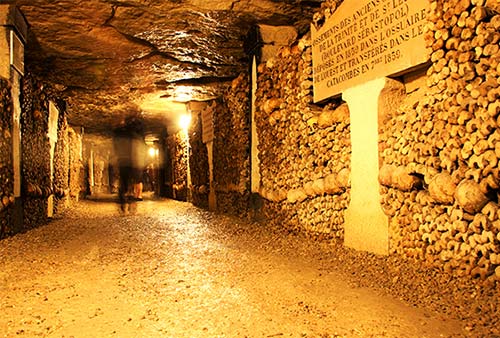
Climb many steps to emerge far from where you entered and find a good WC and a ghoulish gift shop selling skulls and more. Note to wannabe Hamlets: An attendant checks your bag at the exit for stolen souvenirs.
After Your Visit: You’ll exit 10 minutes from where you started, at 21 Avenue René Coty (marked on the “Left Bank” map, earlier). From the exit, turn right and stroll down the center of the pleasing walkway to the Denfert-Rochereau Métro station. Traffic-free Rue Daguerre, a pleasing pedestrian street, is a block from the Denfert-Rochereau Métro off Avenue du Général Leclerc (a block from where you entered the Catacombs; see the Shopping in Paris chapter).
For a review of sights within this kid-friendly gardener’s mecca, see the Paris with Children chapter.
The Paris region is home to 1.7 million Muslims, many from France’s former North African colonies (Algeria, Morocco, and Tunisia)—though most live in vast suburbs where tourists rarely venture. But just next to the Latin Quarter, a handy and inviting bit of Muslim Paris offers an intriguing glimpse at that world, with a mosque, a cultural center, and a popular teahouse.
This mosque was founded in 1926 in gratitude for the sacrifices made by Muslims from France’s colonial empire, who fought the Germans alongside the French in World War I (100,000 Muslims died in this effort). During World War II, the mosque provided refuge for Algerian and European Jews. Today’s mosque is busy with worshippers, yet still welcomes non-Muslim visitors (be considerate and dress modestly; women don’t need head scarves).
Cost and Hours: €3, Sat-Thu 9:00-18:00, closed to visitors Fri and on Muslim holidays, 2 bis Place du Puits de l’Ermite, Mo: Censier-Daubenton, Jussieu, or Place Monge, www.grandemosqueedeparis.fr.
Eating at the Mosque: The Restaurant La Mosquée hides at the back of the mosque with wonderful Arabic ambience, a tea room with tasty baked goods and teas, and delicious meals (see listing on here).
Visiting the Mosque: The entrance is next to the tall minaret. Loop through its rooms and appreciate intricate wood-carved arches over whitewashed walls and elaborate tile work, with no images of humans anywhere. You’ll start in the main courtyard (called a sahn) with a central fountain (for ablutions before prayer, which now take place below), and tour the mosque counterclockwise. Admire the exquisite detail in the capitals and wall sculptures. Peer into the large prayer hall (which non-Muslims and all women are prohibited from entering—Muslim women worship in a basement room). Exit the courtyard through the doorway at the far-right corner and find a sumptuous library and meeting rooms, all surrounding a peaceful garden patio.
Founded in 1980 to improve understanding of the Arab world in France with a museum and special exhibits, the Arab World Institute’s striking, modern building also has free, 180-degree views over the river from its roof terrace.
Cost and Hours: Terrace-free, museum-€8, not covered by Museum Pass; Tue-Sun 10:00-18:00 (museum open until 19:00 on Sat-Sun), closed Mon; for terrace view don’t wait in special exhibit line—ask for entrance for “la terrasse,” 1 Rue des Fossés Saint-Bernard, Place Mohammed V, Mo: Jussieu, +33 1 40 51 38 38, www.imarabe.org.
This famous boulevard is Paris’ backbone, with its greatest concentration of traffic (although it’s delightfully traffic-free on the first Sun of the month). From the Arc de Triomphe down Avenue des Champs-Elysées, all of France seems to converge on Place de la Concorde, the city’s largest square. And though the Champs-Elysées has become as international as it is Parisian, a walk down the two-mile boulevard is still a must.
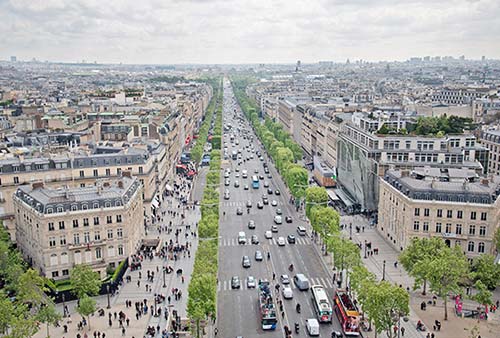
To reach the top of the Champs-Elysées, take the Métro to the Arc de Triomphe (Mo: Charles de Gaulle-Etoile), then saunter down the grand boulevard (Métro stops every few blocks, including George V and Franklin D. Roosevelt).
 See the Champs-Elysées Walk chapter.
See the Champs-Elysées Walk chapter.
Napoleon had the magnificent Arc de Triomphe commissioned to commemorate his victory at the 1805 battle of Austerlitz. The foot of the arch is a stage on which the last two centuries of Parisian history have played out—from the funeral of Napoleon to the goose-stepping arrival of the Nazis to the triumphant return of Charles de Gaulle after the Allied liberation. Examine the carvings on the pillars, featuring a mighty Napoleon and excitable Lady Liberty. Pay your respects at the Tomb of the Unknown Soldier. Then climb the 284 steps to the observation deck up top, with sweeping skyline panoramas and a mesmerizing view down onto the traffic that swirls around the arch.
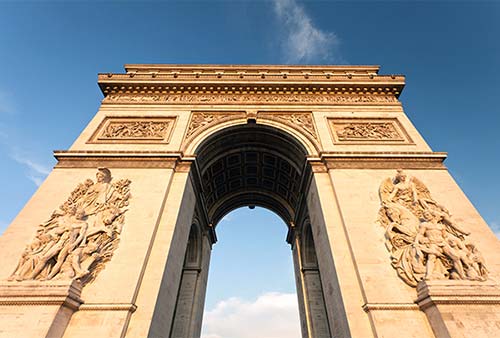
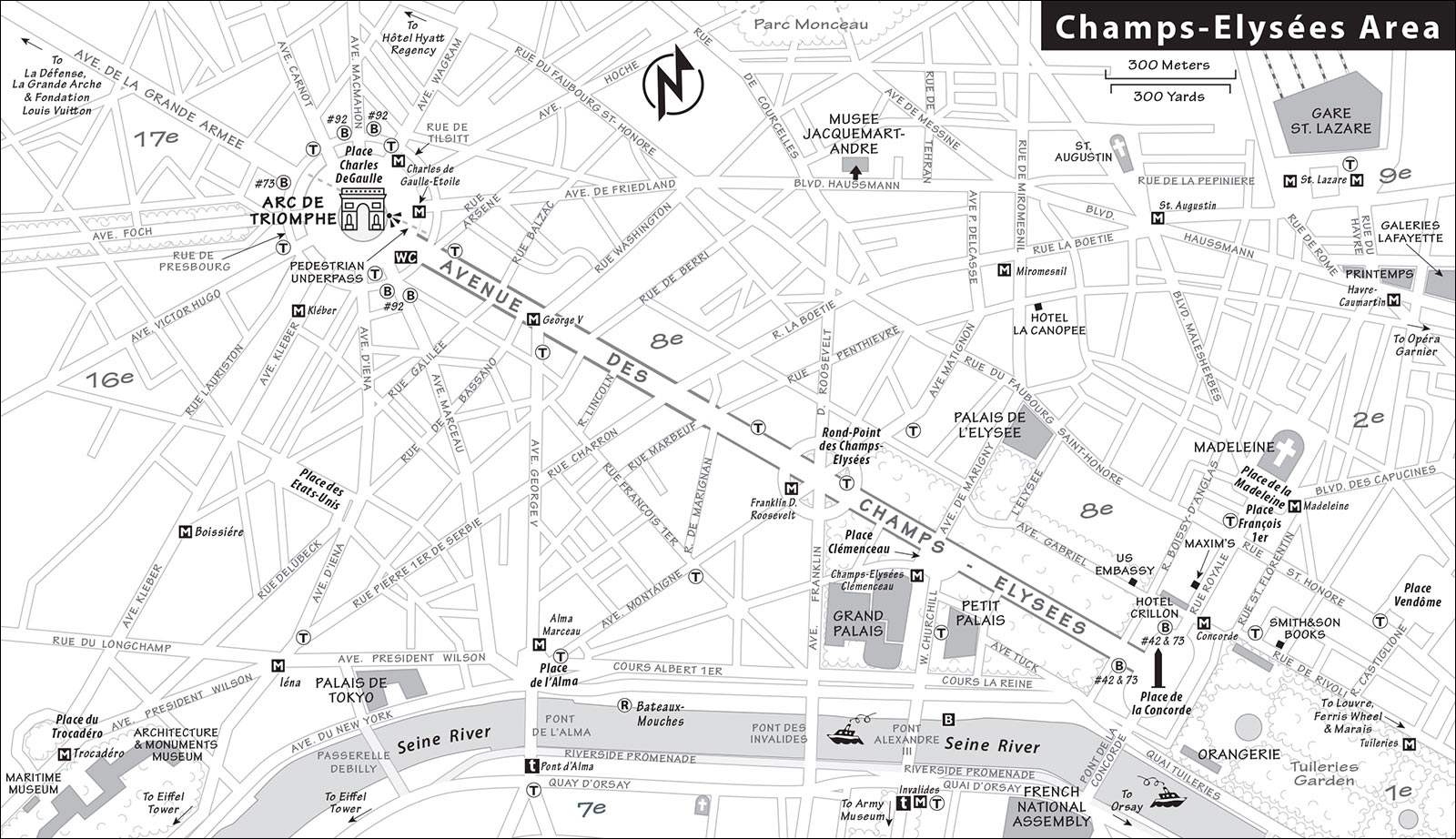
Cost and Hours: Free to view exterior; steps to rooftop-€13, timed-entry tickets available online, free for those under age 18, free on first Sun of the month Nov-March, covered by Museum Pass (reservation not necessary), pass holders and timed-entry ticket holders can skip the lines; daily 10:00-23:00, Oct-March until 22:30, last entry 45 minutes before closing; Place Charles de Gaulle, use underpass to reach arch, Mo: Charles de Gaulle-Etoile, +33 1 55 37 73 77, www.paris-arc-de-triomphe.fr.
 See the Champs-Elysées Walk chapter.
See the Champs-Elysées Walk chapter.
This free museum displays a broad collection of paintings and sculpture from the 1600s to the 1900s on its ground floor, and an easy-to-appreciate collection of art from Greek antiquities to Art Nouveau in its basement. While the collection can be shuffled about for special exhibits, the part I describe is usually unaffected. Though it houses mostly second-tier art, there are a few diamonds in the rough (including works by Rembrandt, Courbet, Cézanne, Sisley, Pissarro, Degas, and Monet). The impressive building was constructed, along with the Grand Palais and Pont Alexandre III, for the 1900 Paris Exhibition (World’s Fair). The museum’s classy café alone merits the detour— and if it’s raining and your Museum Pass has expired, or you just need a clean WC, the Petit Palais is a worthwhile stop.
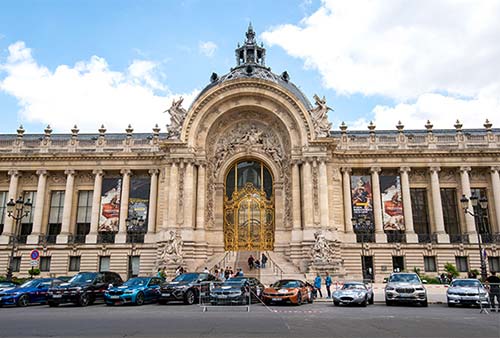
Cost and Hours: Free; Tue-Sun 10:00-18:00, Fri until 21:00 for special exhibits (fee), closed Mon; across from Grand Palais on Avenue Winston Churchill, a looooong block west of Place de la Concorde, Mo: Champs-Elysées Clemenceau; lovely café, +33 1 53 43 40 00, www.petitpalais.paris.fr.
Visiting the Museum: Avoid the special exhibits line and walk up to the museum, through security, and up the main hall to the left (WCs are downstairs from the entry). Along the way, you’ll pass an intriguing collection of 19th-century statues commissioned by the city, all with English descriptions. These are all plaster casts, as their bronze brothers were melted down during World War II.
Turn right into the second hall and find the large painting gallery that features Romantics and Realists from the late 19th century. Midway down the main hall on the left, Courbet’s soft-porn The Sleepers (Le Sommeil, 1866) captures two women nestled in post-climactic bliss. A few paintings down, his large, dark Firefighters (Pompiers courant à un incendie) is a Realist’s take on an everyday scene—firefighters rushing to put out a blaze. On the opposite wall, notice another scene from everyday life in Paris—the massive produce market that once thrived at Les Halles (now a modern mall).
Turning the corner, you’ll see artwork by Gustave Doré (1832-1883), best known as the 19th century’s greatest book illustrator. In his enormous La Vallée de Larmes (1883), Christ and the cross are the only salvation from this “valley of tears.” (The doorway behind the painting leads directly to the museum café.)
Walk left into the bright room, then make a right to find Claude Monet’s Sunset on the Seine at Lavacourt (Soleil couchant sur la Seine a Lavacourt, 1880). Painted the winter after his wife died, it looks across the river from Monet’s home to two lonely boats in the distance, with the hazy town on the far bank. The sun’s reflection is a vertical smudge down the water. Nearby you should find works by Alfred Sisley, Edgar Dégas, Camille Pissarro, Eugène Boudin, and the American painter Mary Cassatt. Boudin’s gray, luminous seascape recalls his Normandy upbringing (Honfleur), and reminds us that he was an early mentor of Claude Monet. He urged Monet to accompany him in Normandy, telling him, “I want you to see the light.” Claude listened.
On the back side of Monet’s Sunset, Paul Cézanne’s Portrait d’Ambroise Vollard (occasionally away on loan) depicts his agent (art dealer), whose job it was to make his paintings go viral—though Cézanne was unknown for most of his life. While Vollard looks somewhat dejected (this painting took 115 sessions to complete), he provided exposure for Cézanne’s work and gave him essential moral support. Notice how Cézanne used blocks of paint rather than brush strokes to create chunkier, geometrical shapes in his works. Continuing into the yellow room, you’re greeted by a few smaller paintings by Paul Cézanne and a Cézanne-looking early work by Paul Gauguin (Vieil Homme au Bâton), painted during his time with Vincent van Gogh in Arles.
Before heading downstairs, double back to the side rooms adjoining the large painting gallery you just visited to find exquisite furniture in the Louis XIV, XV, and XVI styles.
The museum’s overlooked basement features a surprising collection of art, with Greek antiquities, a gorgeous room of medieval iconography, rooms filled with art by Dutch masters, and beautiful displays of Art Nouveau furniture. English explanations in every room help bring these works to life.
This grand exhibition hall, built for the 1900 World’s Fair, is used for temporary exhibits (and is closed for renovation until at least 2025; temporary exhibits are set up at the south end of the Champ de Mars park). The building’s Industrial Age, Erector set-like iron-and-glass exterior is striking (Avenue Winston Churchill, Mo: Champs-Elysées Clemenceau or Franklin D. Roosevelt, tel. +33 1 44 13 17 17, www.grandpalais.fr).
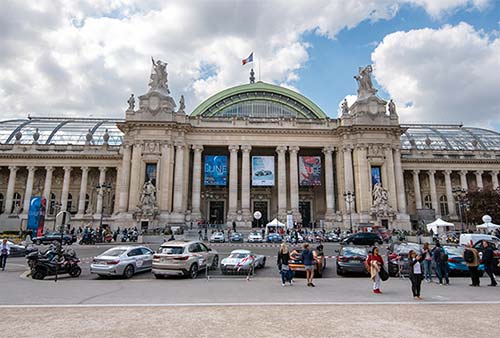
In summer, the Paris Ferris Wheel offers a sensational 200-foot-high view of the city from the northern side of the Tuileries Garden. The towering wheel is the centerpiece of a funfair complete with kid-pleasing rides and games.
Cost and Hours: €12 ticket covers two slow revolutions, two passengers per gondola, open long hours daily late June-late Aug.
For a remarkable Parisian panorama, head to Hôtel Hyatt Regency Paris Etoile and its Windo Skybar on the 34th floor. Ride the free elevators to floor 33 and walk up one flight to the bar. You’ll enter a sky-high world of comfy chairs, glass walls, expensive drinks, and jaw-dropping views that are best before dark and not worthwhile in poor weather (bar open daily 17:00-late, +33 1 40 68 51 31, www.windoparis.com).
Getting There: It’s at Porte Maillot (3 Place du Général Koenig). Take the Métro to the pedestrian-unfriendly Porte Maillot stop. Follow brown signs to Palais des Congrès and exit the station to daylight. You’ll see the tall Hôtel Hyatt Regency—a five-minute walk away, behind the Palais des Congrès. If you’re coming from the Rue Cler area, take RER/Train-C from Invalides or Pont de l’Alma to Porte Maillot (direction: Pontoise). Follow Palais des Congrès signs—you’ll probably walk through an underground mall (if you get lost there are maps everywhere in the mall). If you’re tired or strapped for time, the skies are clear, and the sun’s about to set, spring for a taxi or Uber.
Business magnate Bernard Arnault commissioned Frank Gehry to design this avant-garde space dedicated to contemporary artistic creation. The Fondation’s strength is its ever-changing exhibitions of cutting-edge works (unless you’re a modern art aficionado, you may not see many “name” artists). No matter what is on display, exhibits are wild enough to write home about. The striking, modern glass building, set in a lush park, is reason enough for many to come. Views from the top floor are invigorating.
Cost and Hours: €16, €5 for those under 18; Wed-Mon 11:00-20:00, Sun from 10:00, Fri until 21:00, closed Tue; 8 Avenue du Mahatma Gandhi Bois de Boulogne, +33 1 40 69 96 00, www.fondationlouisvuitton.fr.
Getting There: Take Métro line 1 to the Les Sablons stop and follow Fondation signs for a half-mile, or take the shuttle bus from near the Arc de Triomphe; find the stop at the corner of Avenue de Friedland and Rue de Tilsitt (3/hour, €1, contactless card only).
Though Paris keeps its historic center classic and skyscraper-free, this district, nicknamed “le petit Manhattan,” offers an impressive excursion into a side of Paris few tourists see: that of a modern-day economic superpower. La Défense was first conceived more than 60 years ago as a US-style forest of skyscrapers that would accommodate the business needs of the modern world. Today La Défense is a thriving commercial and shopping center, home to 150,000 employees and 55,000 residents. It’s also the single largest concentration of skyscrapers in all of Europe. You’ll also find the second location of the spectacular Espace Notre-Dame exhibit and virtual reality experience (described on here).
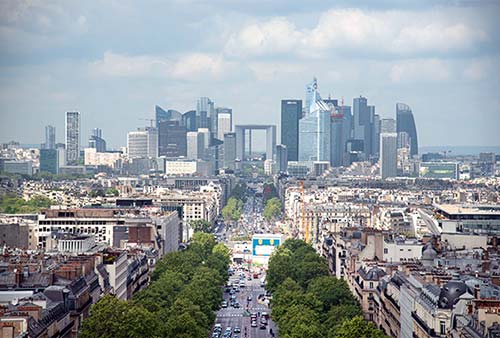
Getting There: For a worthwhile visit, take the Métro to the La Défense Grande Arche stop (last stop on line 1), follow brown Sortie Grande Arche or Arena signs (there are many—they all get you there), and climb to the base of La Grande Arche for distant city views. Then stroll about three-quarters of a mile gradually downhill among the glass buildings to the Esplanade de la Défense Métro station, and return home from there. Mall stores are open every day.
Visiting La Défense: The centerpiece of this ambitious complex is the mammoth La Grande Arche de la Fraternité. Inaugurated in 1989 on the 200th anniversary of the French Revolution, it was, like the Revolution, dedicated to human rights and brotherhood. The place is big—Notre-Dame Cathedral could fit under its arch. The four-sided structure sits on enormous underground pillars and is covered with a veneer of beautiful white Carrara marble. The arch is a 38-story office building for 30,000 people on more than 200 acres. The left side houses government ministries, the right side corporate offices, and the top is dedicated to human rights. The “cloud”—a huge canvas canopy under the arch—is an attempt to cut down on the wind-tunnel effect this gigantic building creates.
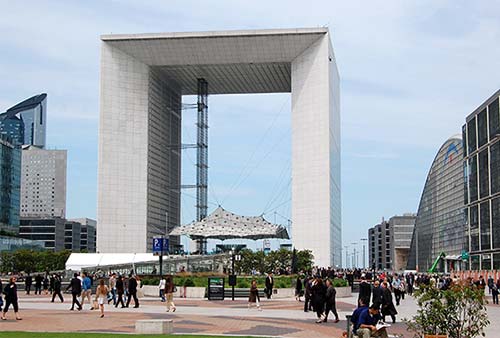
Wander behind the arch, past freestanding glass sheets that help to deflect wind, to see an unusual mix of glassy skyscrapers and a cemetery (in the orchard). Study the Le Corbusier-style planning, where motor traffic is separated from broad pedestrian walkways (there’s a freeway below you and trains tunnel underneath).
Back on the mall side, notice the Arc de Triomphe in the distance, bull’s-eye down the Esplanade. La Grande Arche aligns perfectly with the Arc de Triomphe, the Obelisk on Place de la Concorde, and the Arc de Triomphe du Carrousel in front of the Louvre.
Drop down the arch’s steps. The Espace Notre-Dame exhibit/virtual reality experience (closed Mon, see here) is below the Grande Arche on the right as you descend the steps—follow signs to Cité d’Histoire (a different multimedia show).
Glide onto the vast Esplanade (a.k.a. “le Parvis”). Survey the skyscraping scene. La Défense is much more than its eye-catching arch—it’s an international power broker. Check out the skyscrapers clockwise: Elior (a bit behind you, to the left), provides businesses with support services for education, leisure, and health care; Engie deals in energy; and EDF is France’s national electric company. Back to the left, that tall brass thing in front of the small trees is one of French artist César Baldaccini’s famous thumb statues (40 feet high).
Continue down the Esplanade toward the city center. Take in the monumental structures around you: Les 4 Temps is a giant shopping mall of 250 stores, and like malls at home, it’s a teenage wasteland when school is out and eerily quiet at night. Go ahead, have a peek and compare with your shopping mall.
Opposite Les 4 Temps, the half-dome Center of New Industries and Technologies (better known as CNIT) was built in 1958 and looks like it. It’s now a congress center and remains a feat of architecture: It’s the largest concrete vault anywhere that rests on only three points. Enter the vault to see a semicircle of dazzling offices and shops that recede as they rise, like the seating in an opera house. The FNAC store on the ground floor has a ticket counter and can book tickets to some sights (like the Louvre) and concerts.
In France, getting a building permit often comes with a requirement to dedicate two percent of the construction cost to art. Hence, the Esplanade is a virtual open-air modern art gallery, sporting pieces by Joan Miró (blue, red, and yellow), Alexander Calder (red), Anthony Caro (long, brown, folded-steel sculpture that resembles the meltdown of a bridge support), and Yaacov Agam (the fountain with colorful stripes and rhythmically dancing spouts), among others. Centered behind Yaacov’s fountain, find La Défense de Paris, the statue that gave the area its name; it recalls the 1870 Franco-Prussian war—a rare bit of old Paris out here in the ’burbs. Several cafés are located here.
As you continue your stroll, you’ll come to some small gardens with benches and areas for boules, which are designed to integrate tradition into this celebration of modern commerce. Note also how the buildings tend to decrease in height and increase in age as you approach Paris’ center. Your walk ends at the amusing fountain of Bassin Takis, next to the Allianz skyscraper, where you’ll find the Esplanade de la Défense Métro station that zips you out of all this modernity and back into town. Near this station, look in the middle of the esplanade for the giant green bench—a fun photo op. Before descending into the Métro, take one last look (perhaps from a perch on that big green bench) back to La Grande Arche to appreciate how far you’ve come.
The glittering Garnier opera house anchors this neighborhood of broad boulevards and grand architecture. This area is also nirvana for high-end shoppers, with the opulent Galeries Lafayette and Printemps stores, the delicate Fragonard Perfume Museum and boutique, and the sumptuous shops that line Place Vendôme and Place de la Madeleine (see the Shopping in Paris chapter for a shopping walk of this area). Key Métro stops include Opéra, Madeleine, and Havre-Caumartin (RER/Train-A: Auber).
A gleaming grand theater of the belle époque, the Palais Garnier was built for Napoleon III and finished in 1875. From Avenue de l’Opéra, once lined with Paris’ most fashionable haunts, the facade suggests “all power to the wealthy.” In the 1980s, that elitism prompted the call for a new opera house built for the people, and the larger Opéra Bastille was situated symbolically on Place de la Bastille, where the French Revolution started in 1789. The smaller Opéra Garnier is now home to ballet, some opera, and other performances.
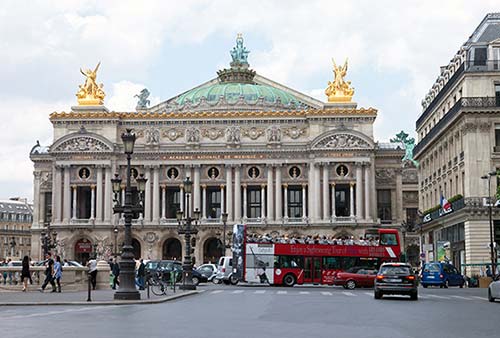
To see the interior, you have several choices: Take a guided tour (a good value), explore the public areas on your own (using the audioguide and/or my self-guided tour, described later), or attend a performance. The auditorium is sometimes off-limits due to performances and rehearsals. Highlights of the interior include the Grand Staircase, the various chandeliered reception halls, the 2,000-seat auditorium, and a few exhibits on the building and opera.
Cost and Hours: €14, €4 off if you show your Orsay Museum ticket (within 5 days of Orsay visit), not covered by Museum Pass; generally daily 10:00-17:00, ticket office closes at 16:15, may be closed some afternoons for rehearsals and during performances; at the corner of Rue Scribe and Rue Auber, Mo: Opéra, RER/Train-A: Auber, www.operadeparis.fr/en/visits/palais-garnier.
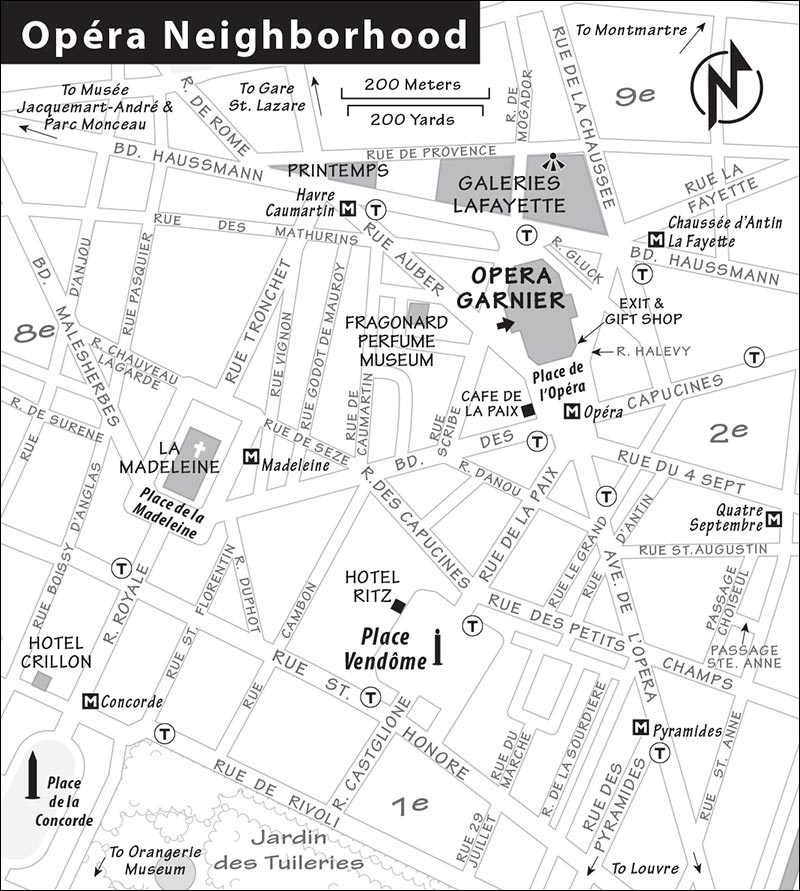
Crowd Control: The Opera gets slammed in the mornings as several guided tours depart between 10:00 and 11:30. It’s quietest after noon.
Tours: While my self-guided tour is sufficient for most, the €6.50 multimedia guide gives a more in-depth tour. Guided tours in English usually run daily every half-hour between 10:00 and 11:30, and again at 15:30; check website to reserve a spot, arrive 30 minutes early for security screening (€18.50, after-hours tours-€22, tours include entry, +33 1 42 46 72 40 or +33 1 42 46 92 10).
Ballet and Concert Tickets: To find out about upcoming performances, ask for a schedule at the information window inside the opera, consult L’Officiel des Spectacles magazine (see here), or see the Paris Opera website (www.operadeparis.fr). There are usually no performances mid-July-Sept. It’s easiest to reserve online but cheaper to buy on performance day. To buy tickets by phone, call +33 1 71 25 24 23 (office closed Sun). You can also go directly to the ticket office (open Mon-Sat 11:30–18:30 and an hour before the show, closed Sun).
 Self-Guided Tour: First, take in the best 1 view of the facade from the traffic island of the Opéra Métro. The building is huge. Its massive foundations straddle an underground lake (inspiring the mysterious world of The Phantom of the Opera). It’s the masterpiece of architect Charles Garnier, who oversaw every element, from laying the foundations to what color the wallpaper should be. His cohesive design was so admired that the building came to be known as the Palais Garnier. (To better understand what you’re seeing, read the “Baron Georges-Eugène Haussmann” sidebar.)
Self-Guided Tour: First, take in the best 1 view of the facade from the traffic island of the Opéra Métro. The building is huge. Its massive foundations straddle an underground lake (inspiring the mysterious world of The Phantom of the Opera). It’s the masterpiece of architect Charles Garnier, who oversaw every element, from laying the foundations to what color the wallpaper should be. His cohesive design was so admired that the building came to be known as the Palais Garnier. (To better understand what you’re seeing, read the “Baron Georges-Eugène Haussmann” sidebar.)
Garnier’s classically inspired facade is a celebration of opera—the art form that combines all the arts. Atop the green dome, a shimmering Apollo, the god of music, holds aloft his shining bronze lyre, as if to declare, “This is a temple of the highest arts.” (You’ll see lyres and Apollos all over the building, outside and in.) Running across the middle of the facade are (smallish) bronze busts of famous composers. The medallions with “E” and “N” honor the Emperor Napoleon III. On the lower right (second statue from the right) is a copy of the well-known Dance by Carpeaux (whose original is in the Orsay).
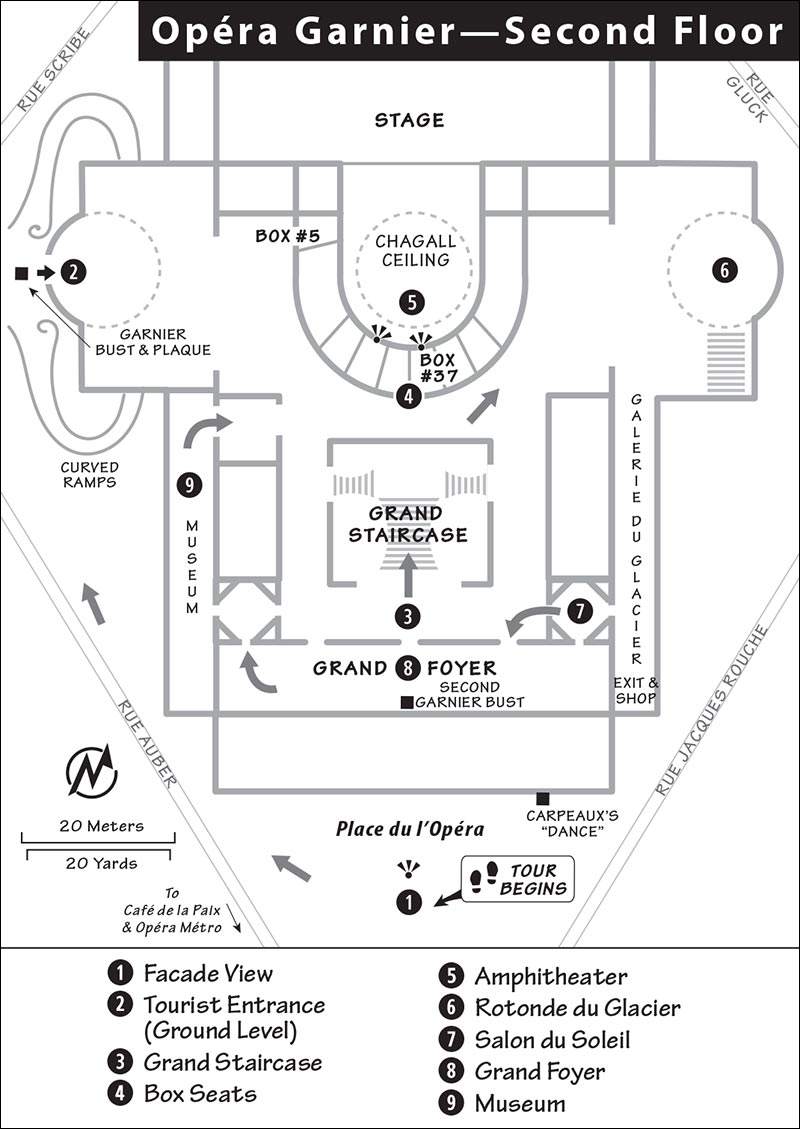
The 2 tourist entrance is around the left side of the building, between the two curved ramps. In fact, this was once the rich patrons’ entrance, as they could drive their carriages right up the ramps and slip in, away from the riff-raff. Before the entrance stands a bust of Garnier and a bronze plaque showing the building’s footprint. Find the horseshoe-shaped seating area (in the center), the rectangular stage (to the left), and the rectangular Grand Staircase (to the right). Notice how little space was given to the seating area itself—the public spaces were paramount.
Enter, buy your ticket, and make your way (up a short staircase) to the foot of the 3 Grand Staircase. Gaze up into this vast hall, where the whole building is united by the set of stairs that branches into a Y midway up. Take in the columns, statues, railings, lanterns, chandeliers, and the different colors of marble, as your eye goes up to a ceiling fresco featuring Apollo. Check out the Grand Staircase from all angles: from the bottom looking up, from the landing as you ascend, and looking back from above. This staircase was the Opera House’s real “stage,” for the evening’s real show: the grand spectacle of elite Parisians—out to see and be seen—strutting their elegant stuff. Mentally populate the space with fin de siècle ladies in flowing satin gowns and white-gloved gentlemen in top hats and tuxes.
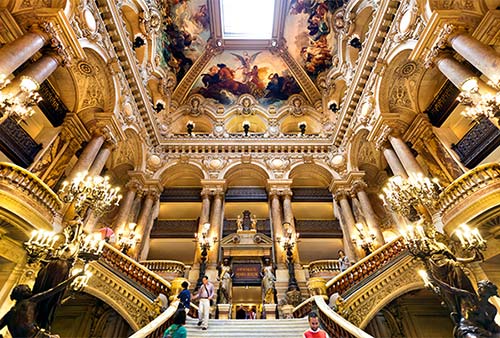
Ascend to the very top of the stairs, where you’ll find the circular auditorium with the numbered doors of the 4 box seats. This is where the rich people watched the opera. Before entering, note the busts between the boxes, honoring great librettists, set designers, dancers, and composers, like Hector Berlioz (near box #37). The famous box #5 (around the left) honors the (fictional) Phantom of the Opera, who always sat here. The novel and musical are based on two historical facts: the building’s underground cistern, and a real incident in which the chandelier fell and killed someone.
Now enter an open box and take in the view of the 5 amphitheater. The red-velvet performance hall seats 2,000. Admire Marc Chagall’s colorful ceiling (1964) playfully dancing around the seven-ton chandelier. If Chagall’s modern depiction of famous operas feels out of place, we’ll soon see the original painting it replaced. The stage curtain is made of canvas, painted to look like...a curtain, seemingly made of velvet, complete with fake folds and tassels. Note the box seats next to the stage—the most expensive in the house, with an obstructed view of the stage—but just right if you’re here only to be seen.
Next, we’ll tour the opulent, chandeliered reception rooms, where operagoers gathered for drinks and socializing during intermission. Start in the far corner with the domed 6 Rotonde du Glacier, where they indulged in ice cream treats under a ceiling painting of Bacchus and his revelers. Among the room’s busts, find Antonio Salieri (Mozart’s rival) and several “divas”—noted singers and dancers, back when dance was one of opera’s best-loved elements. (In fact, most performances here today are by the Opéra Garnier’s dance company.)
Head down the long, chandelier-strewn Galerie du Glacier, and turn right (just before the end) into the tiny 7 Salon du Soleil. This Room of the Sun dazzles the eye with a black-and-gold sunray ceiling and walls fitted with infinity mirrors.
Continue straight to the Grand Staircase and turn left, entering the large and over-the-top opulent 8 Grand Foyer. This long, high-ceilinged Hall-of-Mirrors-esque space was the main gathering place at intermission. Its golden decor (mostly gold paint, not gilding) features statues, columns, and chandeliers, all set off by colorful ceiling paintings. Find 20 lyres in a minute. The statues at either end, by the fireplaces, are 24-carat gold, and visibly shinier than the gold-painted statues. Garnier proudly put his own bust here (halfway down the foyer on the left), eternally admiring his fine work. (Garnier’s next major project was the famous Monte Carlo casino and opera house.) Step outside onto the balcony (or look out the windows), and you realize this room sits in the middle story of the facade, overlooking Place de l’Opéra.
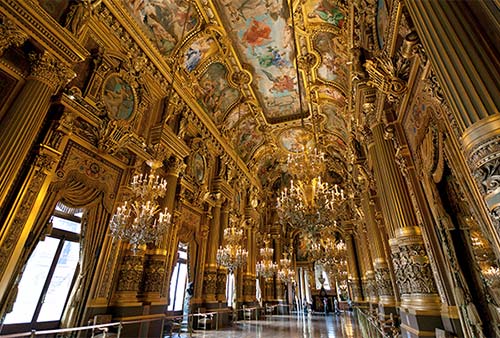
Exit the Grand Foyer at the far end, pass through the tiny Salon de la Lune (Soleil’s nocturnal counterpart), and turn left into the 9 museum. Browse the long hallway of exhibits, starting immediately with a cutaway model of the stage (with two subterranean levels below and elaborate pulleys above), followed by paintings of famous singers, dancers, composers, and set designers. Farther down on the right is a round gold-framed work depicting the original ceiling painting that graced the auditorium before Chagall came along. Muses spin and cavort among the fluffy clouds of heaven. The museum leads into the library, with dioramas of set designs for famous operas, including Faust, by Paris’ hometown boy Charles Gounod.
Head downstairs (where there are often other exhibits) and enjoy one more view from the foot of the Grand Staircase. Exit through the appropriately elegant gift shop on the opposite side from where you entered.
Nearby: The illustrious Café de la Paix faces the Opera’s front and has been a meeting spot for the local glitterati for generations. If you can afford the coffee, this spot offers a delightful break.
Located across from the Opéra entrance, this perfume shop offers a good look at how and where perfume is made in its three-room “museum” (entrance to the left of the boutique). Housed in a beautiful 19th-century mansion, it’s the best-smelling museum in Paris (well-described in English).
Cost and Hours: Free, Mon-Sat 9:00-18:00, Sun until 17:00, 3 Square Louis Jouvet, +33 1 47 42 04 56, http://musee-parfum-paris.fragonard.com/en/.
The upscale Opéra neighborhood hosts some of Paris’ best shopping. Even window shoppers can appreciate this as a ▲ “sight.” Just behind the Opéra, the Galeries Lafayette department store is a magnificent cathedral to consumerism, under a stunning stained-glass dome. The area between Place de la Madeleine, dominated by the Madeleine Church (looking like a Roman temple), and the octagonal Place Vendôme, is filled with pricey shops and boutiques, giving travelers a whiff of the exclusive side of Paris (for more on Galeries Lafayette or for a boutique-to-boutique stroll through this area, see the Shopping in Paris chapter).
This enjoyable museum-mansion, which should be open by late 2024 after undergoing a major renovation, showcases the lavish home of a wealthy, art-loving, 19th-century Parisian couple and an elegant café. After visiting the Opéra Garnier and wandering Paris’ grand boulevards, get inside for an intimate look at the lifestyles of the Parisian rich and fabulous. Edouard André and his wife Nélie Jacquemart spent their lives and fortunes designing, building, and then decorating this sumptuous mansion. What makes the visit worthwhile is the helpful audioguide tour (included with admission, plan on spending an hour with the audioguide). The place is strewn with paintings by Rembrandt, Botticelli, Uccello, Mantegna, Bellini, Boucher, and Fragonard. Though there are no must-see masterpieces, the art gathered here would still be enough to make any gallery famous.
Cost and Hours: €12, €3-5 more for special exhibits (which are common), includes audioguide, not covered by Museum Pass; daily 10:00-18:00, Mon until 20:30 during special exhibits; avoid lines on weekends and during the first week of special exhibits by purchasing skip-the-line tickets online in advance, 158 Boulevard Haussmann, Mo: St-Philippe-du-Roule, bus #80 connects conveniently with Ecole Militaire; +33 1 45 62 11 59, www.musee-jacquemart-andre.com.
Visiting the Museum: While you follow the audioguide, keep an eye out for these highlights.
The Antechamber introduces you to the museum’s winning formula: opulent decor (chandeliers, red velvet walls, gilded trim) + semi-famous paintings (two Boucher nudes and two Canaletto scenes of Venice) + the lifestyle of Edouard and Nélie (who received visitors here) = an immersive aesthetic experience. Next, you enter the Versailles-like Grand Salon, the central focus for their parties, with a guest list of up to 1,000.
After passing through several rooms of Edouard’s collection of beautiful things—furniture, tapestries, exotic curios, and Tiepolo paintings on the ceiling—you’ll reach the Library, displaying portraits by Rembrandt, Hals, and Van Dyck, and Rembrandt’s Supper at Emmaus.
Backtracking, you reach the spacious Music Room, used for candlelit parties and concerts. (The band was perched on the balconies above, so the music seemed to waft down from heaven.) Find the bronze bust of Edouard, age 57, done by his wife, Nélie. They’d met when he hired her to do his portrait. The Winter Room is fitted with skylights and exotic plants, to brighten a sunny day. It leads into the Smoking Room—the belle époque man cave.
Upstairs, you enter the world of Italian art. You pass a mural by Tiepolo and enter the Studio, which Edouard made for his artist wife to work in. Among the many (minor) sculptures displayed now, locate Luca della Robbia’s ceramic Madonna and Donatello’s small bronze torchbearer. The Florentine and Venetian Painting Rooms have Botticelli’s Virgin and Child, a Giovanni Bellini Madonna, Mantegna’s Ecce Homo, and works by Uccello, Guardi, and Carpaccio.
Downstairs are the couple’s Private Apartments. They kept separate bedrooms (one for “Madame,” one for “Monsieur”) but met in the room in between for breakfast. There you’ll see the portrait that Nélie painted of Edouard when they first met—the spark that brought about their marriage, their mutual passion for art, and eventually the Jacquemart-André Museum.
After Your Visit: Consider a break in the sumptuous museum tearoom, with delicious cakes and tea (daily 11:45-17:30). From here walk north on Rue de Courcelles to see Paris’ most beautiful park, Parc Monceau.
The Marais neighborhood extends along the Right Bank of the Seine, from the Bastille to the Pompidou Center. The main east-west axis is formed by Rue St. Antoine, Rue des Rosiers (the heart of Paris’ Jewish community), and Rue Ste. Croix de la Bretonnerie. The centerpiece of the neighborhood is the stately Place des Vosges. Helpful Métro stops are Bastille, St-Paul, and Hôtel de Ville.
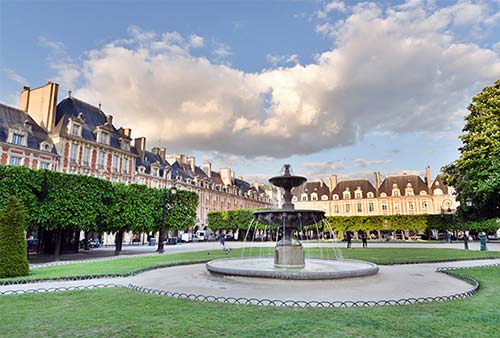
Don’t waste time looking for the Bastille, the prison of Revolution fame. It’s Paris’ most famous nonsight. The building is long gone, and just the square remains, good only for its nightlife and as a jumping-off point for the Marais Walk or a stroll through La Coulée Verte.
 The Marais Walk chapter connects the following sights with a fun, fact-filled stroll.
The Marais Walk chapter connects the following sights with a fun, fact-filled stroll.
Housed in three floors of an elegant mansion, this museum delves into the history of Paris—all wonderfully explained with English descriptions, making it quite user-friendly (once you figure out the confusing floorplan). A fine statue of Louis XIV greets you in the elegant courtyard, as if saying, “Hey, this place is underrated, free, and gives the best history lesson anywhere for those wanting to better understand Paris.”
Inside, French history unfolds in a series of stills—like a Ken Burns documentary, except you have to walk. You get a good overview of everything—from Louis XIV-period rooms, to Napoleon, to the belle époque. There’s even a delightful basement exhibit on prehistoric, ancient Roman, and medieval Paris. But I’d focus on the museum’s highlight: the French Revolution and the 19th century. In fact, the museum was established on the 100th anniversary of the French Revolution, and it features surviving treasures and artifacts from that turning point in western democracy. A thoughtful visit here gives valuable context to what you’ll see throughout the rest of your Paris sightseeing.
Cost and Hours: Free, Tue-Sun 10:00-18:00, closed Mon, 16 Rue des Francs Bourgeois, Mo: St-Paul, www.carnavalet.paris.fr. The museum has a good recommended courtyard café (see here).
Visiting the Museum: Upon entry, lock up your coat and bag. While there are other sections in the museum, I find the following exhibits most important and interesting. From the first room on the ground floor, climb the curvy wooden staircase. At the top, go straight down a corridor and climb a second curvy wooden staircase. On the top floor, straight ahead is the section called “The French Revolution to the 21st Century.” A small painting of the Declaration of the Rights of Man (the French answer to the US Declaration of Independence) welcomes you to a long, winding, and chronological exhibit on the French Revolution. Each room starts with a concise historic recap, with displays that are both fascinating and well-described in English. You’ll see the roots of revolution, divine monarchs and angry masses, the Bastille prison, royals who lost their heads, revolutionary heroes, the Reign of Terror, and Napoleon.
Popping out the other end, you’ve survived the Revolution. Another curvy wooden staircase leads down to another fascinating era: “Paris 1852 to Today.” Following Sens de la Visite signs, you’ll wind through a series of rooms that illustrate the foundations of the Paris we know and love today. The exhibit starts with Baron Haussmann and his late-19th-century redesign of the city, then traces the fin de siècle and beyond: cancan dancers, the Eiffel Tower, hot-air balloons, the belle époque, Art Nouveau, and the Impressionists.
Cap your visit with some ancient history. At the foot of the curvy staircase on the ground floor, make a right into the room with old shop signs, passing under a big pair of scissors. Go through several rooms filled with more Parisian memorabilia to a humble staircase leading into a medieval cellar. Here you’ll find artifacts, art, and carvings from megalithic Paris (4000 BC), helping you envision the tribes that first settled on the island in the Seine. You’ll also learn about the ancient Roman city of Lutetia (which became Paris) and medieval life here, illustrating the rise of this great city.
Whatever you think about Picasso the man, as an artist he was unmatched in the 20th century for his daring and productivity. This museum rotates its huge collection of Picasso works to host an ever-changing calendar of Picasso-themed exhibits.
Cost and Hours: €14, covered by Museum Pass, free on first Sun of month; open Tue-Fri 10:30-18:00, Sat-Sun from 9:30, closed Mon, last entry 45 minutes before closing; 5 Rue de Thorigny, Mo: St-Sébastien-Froissart, St-Paul, or Chemin Vert, +33 1 42 71 25 21, www.museepicassoparis.fr.
This is a fine museum of historical artifacts and rare ritual objects spanning the Jewish people’s long cultural heritage. It emphasizes the cultural unity maintained by this continually dispersed population. You’ll learn about Jewish traditions and see exquisite costumes and objects central to daily life and religious practices. Novices may find the displays beautiful and thought-provoking but not especially meaningful. Those with a background in Judaism or who take the time with the thoughtful audioguide and posted information will be rewarded.
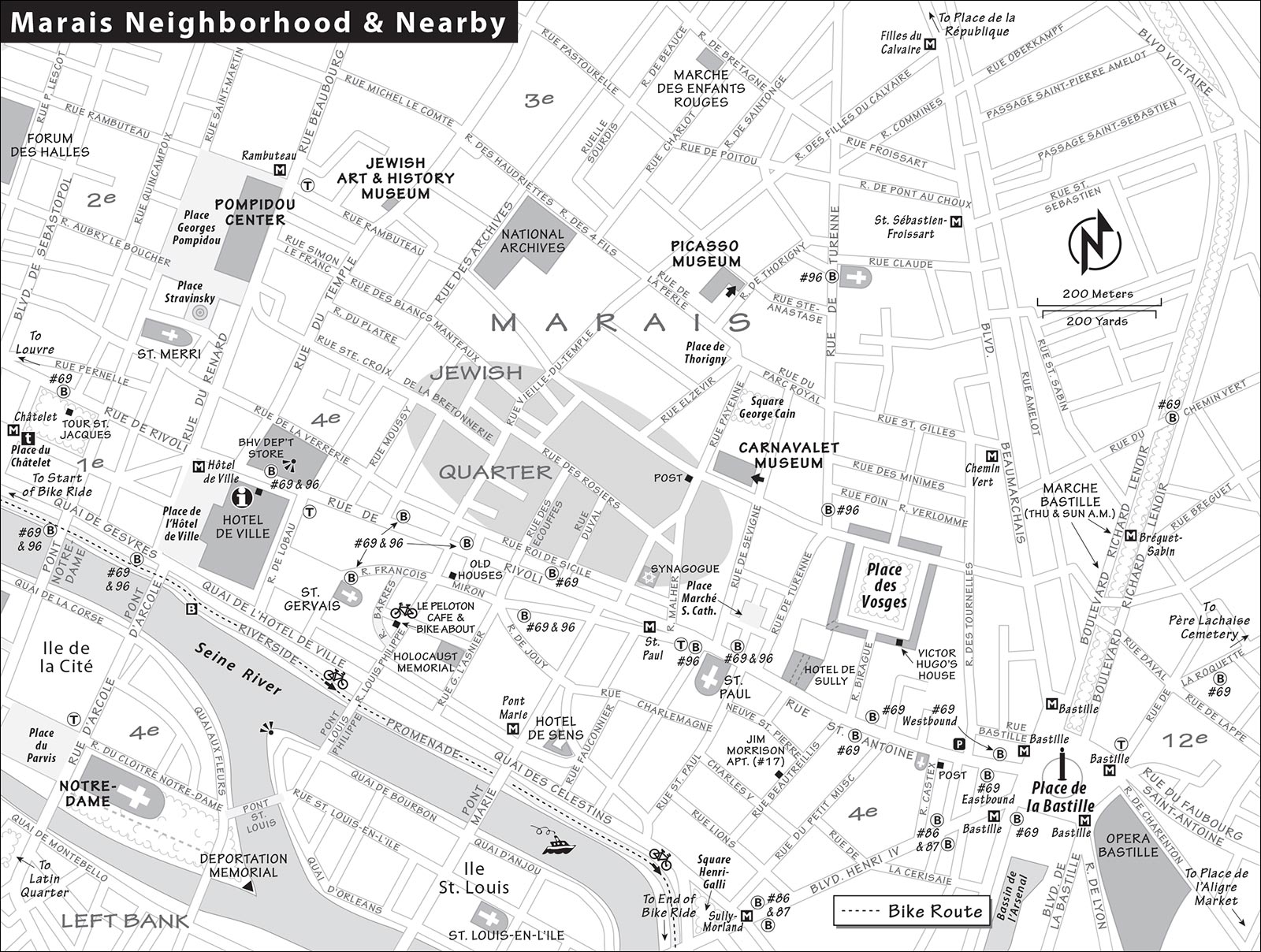
Cost and Hours: €10, includes audioguide, covered by Museum Pass, free on first Sat of month Oct-June; Tue-Fri 11:00-18:00, Sat-Sun from 10:00, open later during special exhibits—Wed until 21:00 and Sat-Sun until 19:00, closed Mon year-round, last entry 45 minutes before closing; 71 Rue du Temple, Mo: Rambuteau or Hôtel de Ville a few blocks farther away, RER/Train-B: Châtelet-Les Halles; +33 1 53 01 86 60, www.mahj.org.
Visiting the Museum: Before entering, visitors undergo a thorough security check. Once inside, your visit starts with a black-and-white display of Jewish life in Paris just before World War II. One floor up, you’re greeted by a centuries-old Torah scroll that introduces the exhibit. The next room covers the early Middle Ages (AD 500-1000), when Judaism flourished in France. A row of excavated gravestones attests to Jews living peacefully on the Ile de la Cité. Then came the Crusade of 1096 and several centuries of persecution, pogroms, and expulsions under Christian kings like “Saint” Louis IX. Continuing on, you’ll see displays on Jewish rituals—getting married under a canopy, menorahs lit during Hanukkah, and gift-giving during Purim. There’s a full-size sukkah (tabernacle), a structure for celebrating the harvest festival, and models of various synagogue styles.
Upstairs, you’ll find many exquisite silver-and-jeweled ritual objects: Torah scrolls and their rich cloth coverings, pointers for reading the Torah, and rams’ horns blown at Rosh Hashanah and Yom Kippur. You’ll see a few paintings by famous Jewish artists, including Marc Chagall, Amedeo Modigliani, and Chaïm Soutine. The museum brings the Jewish story up to modern times. French Jews were “Emancipated” during the Enlightenment of the 1700s. But anti-Semitism lingered, as illustrated by the final exhibit: the Dreyfus Affair (c. 1900). A French officer was accused of treason. Was he guilty, or merely guilty of being Jewish?
This sight, commemorating the lives of the more than 76,000 Jews deported from France in World War II, has several facets: a WWII deportation memorial, a museum on the Holocaust, and a Jewish resource center. Displaying original deportation records, the museum takes you through the history of Jews in Europe and France, from medieval pogroms to the Nazi era. But its focal point is underground, where victims’ ashes are buried.
Cost and Hours: Free, Sun-Fri 10:00-18:00, Thu until 22:00, closed Sat and certain Jewish holidays, 17 Rue Geoffroy l’Asnier, +33 1 42 77 44 72, www.memorialdelashoah.org.
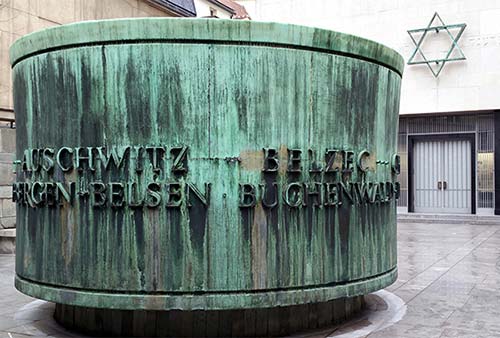
Visiting the Memorial: To the right of the entrance, on the Allée des Justes, notice the large bronze wall plaque honoring those who risked their lives for Jewish people. The entry courtyard (after the security check) contains a cylinder evoking concentration camp smokestacks. Down three steps, large stone walls are engraved with the names of French Jews deported during the war.
Enter the building (with an information desk, bookstore, and exhibits), and pick up the Mémorial de la Shoah brochure. Go downstairs one floor to the crypt, and find a large Star of David in black marble. Ashes from some of the six million victims of Nazi brutality are buried underneath the star, in soil brought from Israel. Behind you is a small corridor containing the original French police files from the arrest, internment, and deportation of Paris’ Jews. (Since 1995, the French have acknowledged the Vichy government’s complicity in the Nazis’ local ethnic cleansing.)
Go downstairs another floor to the permanent exhibition. Photos and videos (most with English explanations) present an introduction to Judaism and the history of Jews in Europe (including pogroms) and in France (including the notorious Dreyfus affair, concerning a Jewish officer unjustly imprisoned for treason). The well-devised displays start with a floor map showing the distribution of the Jewish population in Europe before World War II. Next, trace the rise of Nazism, the deportations and France’s collaboration with them (12,884 Parisians were once rounded up in a single day and 76,000 were deported from throughout France), the death camps, and the liberation at the end of the war. The moving finale is a brightly lit collage of children lost to the Holocaust.
One of Europe’s greatest collections of far-out modern art is housed in the Musée National d’Art Moderne (note that it’s due to close in late 2025 for a multiyear renovation). While this sprawling arts center is huge, most visitors focus on the fourth and fifth floors of this colorful exoskeletal building. Created ahead of its time, the modern and contemporary art in this collection is still waiting for the world to catch up. After so many Madonnas-and-children, a piano smashed to bits and glued to the wall can be refreshing.
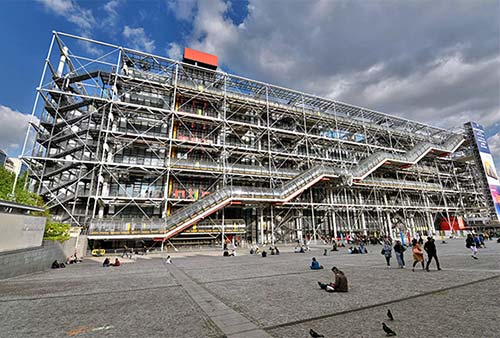
The Pompidou Center and the square that fronts it are lively, with lots of people, street theater, and activity inside and out—a perpetual street fair. Kids of any age enjoy the fun, colorful fountain (an homage to composer Igor Stravinsky) next to the Pompidou Center. The free exterior escalators lead to a great city view from the sixth floor.
Cost and Hours: €15, €12 for those 18-25, free for kids 17 and under, free escalator to sixth-floor view, free on first Sun of the month—book a time slot; Museum Pass covers permanent collection (plus occasional special exhibits); permanent collection open Wed-Mon 11:00-21:00, closed Tue, ticket counters close at 20:00; rest of the building open until 22:00 (Thu until 23:00); arrive after 17:00 to avoid crowds (mainly for special exhibits); café on mezzanine, pricey view restaurant on level 6, Mo: Rambuteau or Hôtel de Ville, +33 1 44 78 12 33, www.centrepompidou.fr.
 See the Pompidou Center Tour chapter.
See the Pompidou Center Tour chapter.
This elevated viaduct was used for train tracks from 1853 to 1969 and is now a three-mile narrow garden walk and a delightful place for a refreshing stroll or run. Botanists appreciate the well-maintained and varying vegetation. From west (near Opéra Bastille) to east, the first half of the path is elevated until the midway point, the pleasant Jardin de Reuilly (a good stopping point for most, near Mo: Dugommier), then it continues at street level—with separate paths for pedestrians and cyclists—out to Paris’ ring road, the périphérique.
Cost and Hours: Free, opens Mon-Fri at 8:00, Sat-Sun at 9:00, closes at sunset (17:30 in winter, 20:30 in summer). It runs from Place de la Bastille (Mo: Bastille) along Avenue Daumesnil to the suburb of St. Mandé (Mo: Michel Bizot or Porte Dorée), passing within a block of Gare de Lyon.
Getting There: To get to the park from Place de la Bastille (exit the Métro following Sortie Rue de Lyon signs), walk a looooong block down Rue de Lyon, hugging the Opéra on your left. Find the low-key entry and steps up the red-brick wall a block after the Opéra.
Littered with the tombstones of many of the city’s most illustrious dead, this is your best one-stop look at Paris’ fascinating, romantic past residents. More like a small city, the cemetery is big and confusing, but my self-guided tour directs you to the graves of Frédéric Chopin, Molière, Edith Piaf, Oscar Wilde, Gertrude Stein, Jim Morrison, Héloïse and Abélard, and many more.
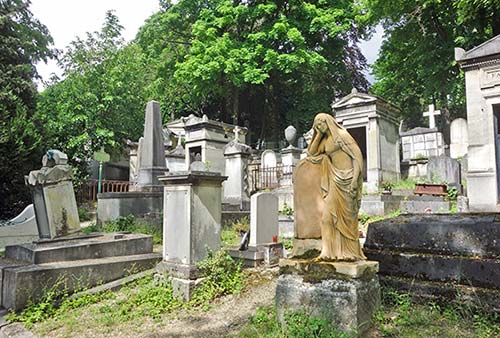
Cost and Hours: Free, Mon-Fri 8:00-18:00, Sat from 8:30, Sun from 9:00, closes at 17:30 in winter; two blocks from Mo: Gambetta (do not go to Mo: Père Lachaise) and two blocks from bus #69’s last stop (see the Bus #69 Sightseeing Tour chapter); +33 1 55 25 82 10, searchable map available at unofficial website: www.pere-lachaise.com [URL inactive].
 See the Père Lachaise Cemetery Tour chapter or
See the Père Lachaise Cemetery Tour chapter or  download my free audio tour for a tomb-by-tomb tour of the most illustrious of these permanent Parisians.
download my free audio tour for a tomb-by-tomb tour of the most illustrious of these permanent Parisians.
France’s literary giant lived in this house on Place des Vosges from 1832 to 1848. Hugo stayed in many places during his life, but he was here the longest. He moved to this apartment after the phenomenal success of The Hunchback of Notre-Dame, and it was while living here that he wrote much of Les Misérables (when he wasn’t entertaining Paris’ elite). After climbing up two floors, you’ll visit well-decorated rooms re-creating different phases of Hugo’s life and passions, from his celebrity years, to his 19-year exile during the repressive reign of Napoleon III (Hugo said “When freedom returns, I will return”), to his final years as a national treasure. Rooms are littered with personal possessions and paintings of Hugo and his family and of some of his most famous character creations. Posted explanations in English provide sufficient context to grasp the importance of Hugo to France.
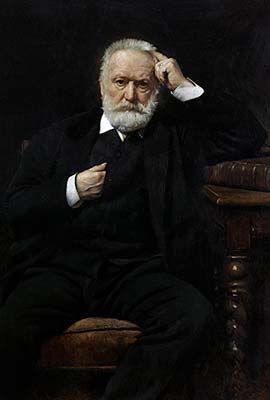
Cost and Hours: Free, fee for optional special exhibits, Tue-Sun 10:00-18:00, closed Mon, peaceful courtyard café, good WCs, 6 Place des Vosges; Mo: Bastille, St-Paul, or Chemin Vert; +33 1 42 72 10 16, http://maisonsvictorhugo.paris.fr.
Paris’ highest hill, rated ▲▲ and topped by Sacré-Cœur Basilica, is best known as the home of cabaret nightlife and bohemian artists. Struggling painters, poets, dreamers, and drunkards came here for cheap rent, untaxed booze, rustic landscapes, and views of the underwear of high-kicking cancan girls at the Moulin Rouge. These days, the hill is equal parts charm and kitsch—still vaguely village-like but mobbed with tourists and pickpockets—especially on sunny weekends. Come for a bit of history, a getaway from Paris’ noisy boulevards, and the view.
 Connect the following sights with this book’s Montmartre Walk (to locate the sights, see the map in that chapter).
Connect the following sights with this book’s Montmartre Walk (to locate the sights, see the map in that chapter).
You’ll spot Sacré-Cœur (Sacred Heart), the onion-domed white basilica atop Montmartre, from most viewpoints in Paris. Though it looks ancient, the impressive and iconic basilica is less than 150 years old (built 1875-1919). With a climbable dome, Sacré-Cœur sits atop Paris’ highest natural point (430 feet).
After the disastrous Franco-Prussian war and subsequent bloodshed between the monarchist French government and Parisian insurgents (Communards), France was humbled and devastated. This basilica was built by Roman Catholics as penance for years of rebellion violence centered in the Montmartre area. The exterior of the basilica is laced with gypsum, which gives it its bleached-bone pallor. Inside, you’ll enjoy wonderful mosaics, a statue of St. Thérèse, a scale model of the church, and three stained-glass windows dedicated to Joan of Arc. Pause near the Stations of the Cross mosaic to give St. Peter’s bronze foot a rub, or for a panoramic view of Paris, climb 260 feet up the tight spiral stairs to the top of the dome.
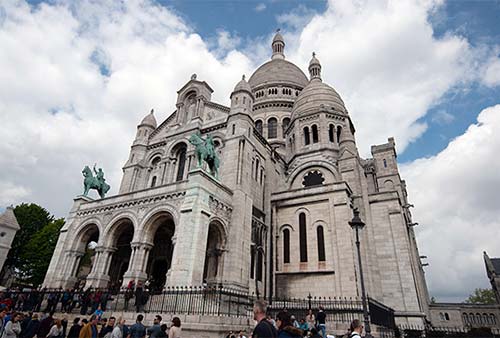
Cost and Hours: Church—free, daily 6:30-22:30; dome—€7, not covered by Museum Pass, daily 10:00-18:00, June-Sept until 19:00, Jan-Feb until 17:00; modest dress required, +33 1 53 41 89 00, www.sacre-coeur-montmartre.com.
Getting There: You can take the Métro to the Anvers stop (to avoid the stairs up to Sacré-Cœur, use your Navigo transit pass and ride up on the funicular). Or, from Place Pigalle, you can take bus #40, which drops you right by Sacré-Cœur (Funiculaire stop, costs one Métro ticket, 4/hour). A taxi from near the Seine saves time and avoids sweat (about €20, €25 at night).
Nearby: To lose the crowd and feel Montmartre’s pulse, explore a few blocks behind Place du Tertre. Go down Rue du Mont Cenis and turn left on Rue Cortot (past the Montmartre Museum). At Rue des Saules take a few steps downhill to see the vineyards that still supply cheap wine, then backtrack up Rue des Saules to the hilltop.
This 17th-century home re-creates the traditional cancan-and-cabaret Montmartre scene, with paintings, posters, photos, music, videos, and memorabilia. It offers the best look at the history of Montmartre and the amazing period from 1870 to 1910 when so much artistic action was percolating in this neighborhood, plus a chance to see the studio of Maurice Utrillo.
Cost and Hours: €15, not covered by Museum Pass; daily 10:00-19:00, Dec-March until 18:00, last entry 45 minutes before closing; 12 Rue Cortot, +33 1 49 25 89 39, www.museedemontmartre.fr.
Paris’ red light district, the infamous “Pig Alley” to WWII servicemen, is at the foot of Butte Montmartre. Oh là là. It’s more racy than dangerous. Walk from Place Pigalle to Place Blanche, teasing desperate barkers and fast-talking temptresses. In bars, a €150 bottle of (what would otherwise be) cheap Champagne comes with a friend. Stick to the bigger streets, hang on to your wallet, and exercise good judgment. Cancan can cost a fortune, as can con artists in topless bars. After dark, countless tour buses line the streets, reminding us that tour guides make big bucks by bringing their groups to touristy nightclubs like the famous Moulin Rouge (Mo: Pigalle or Abbesses).